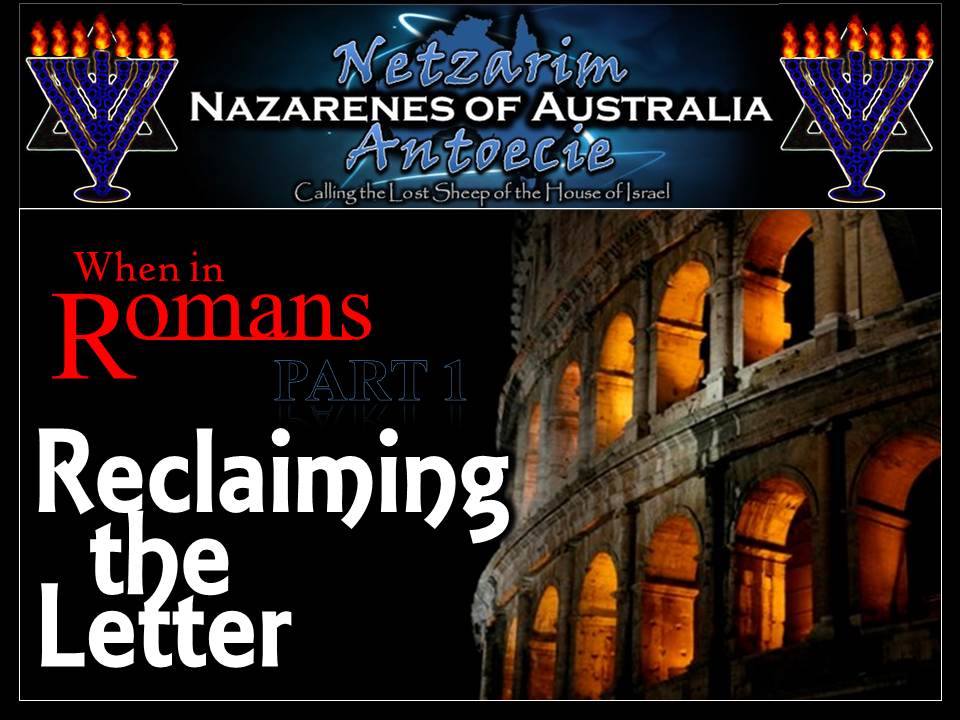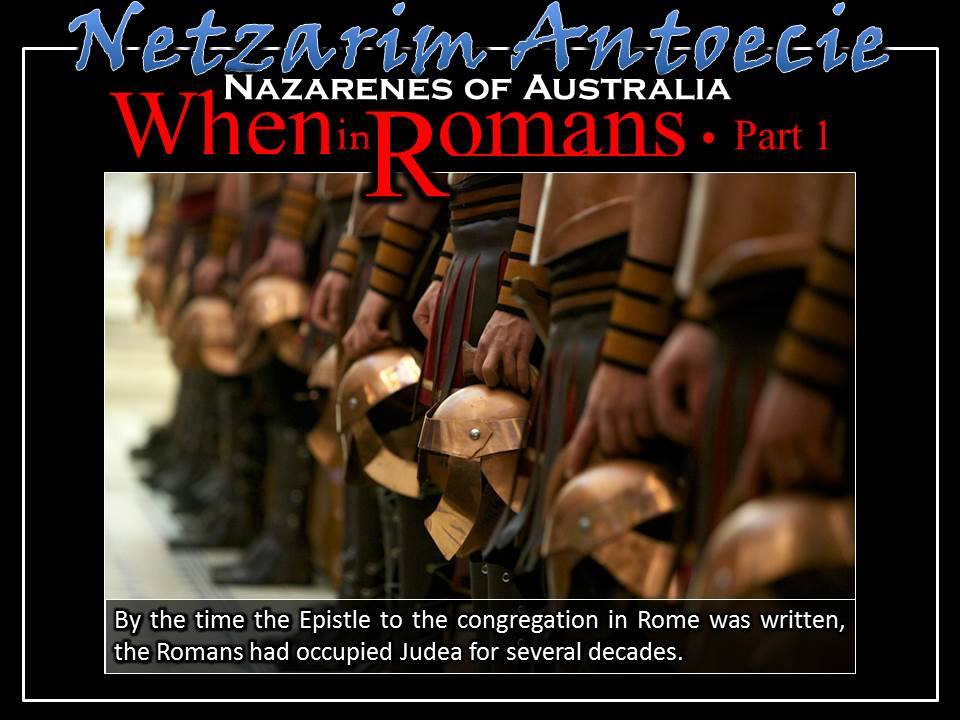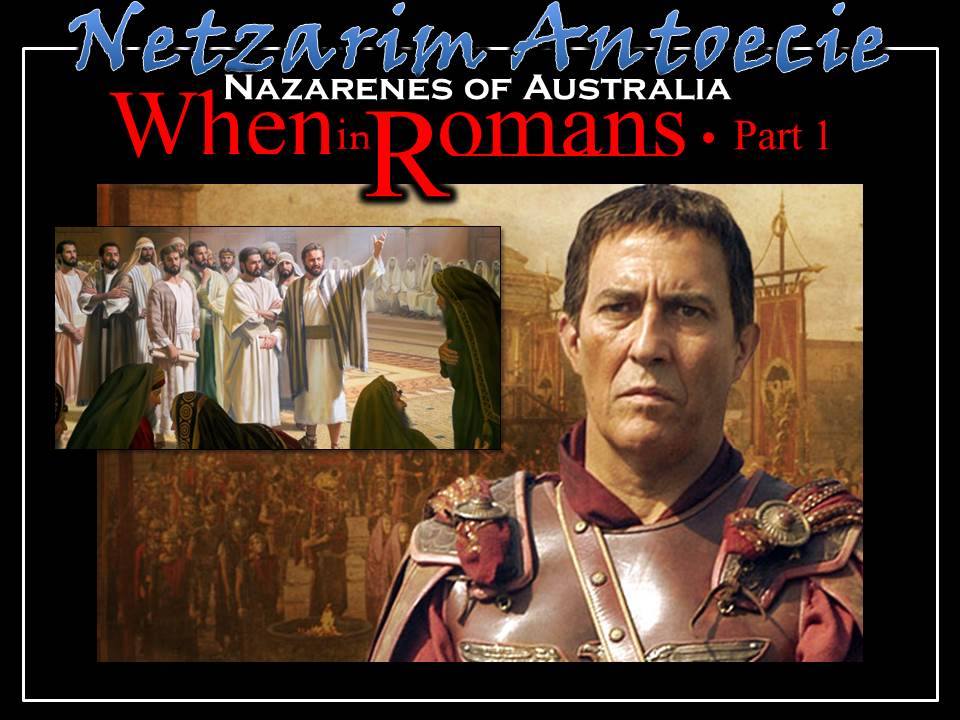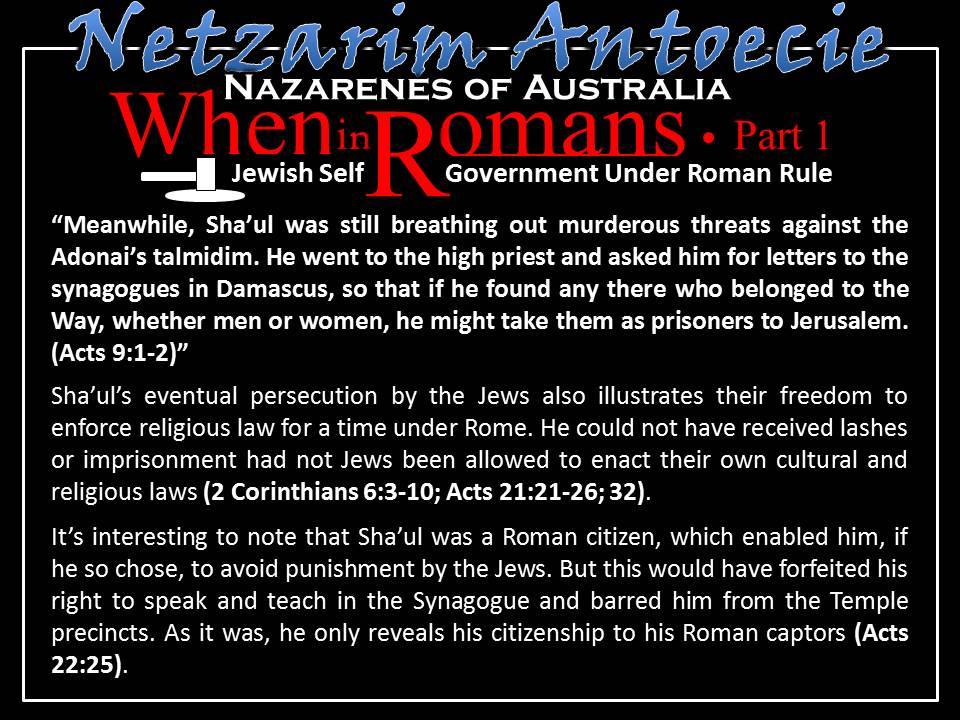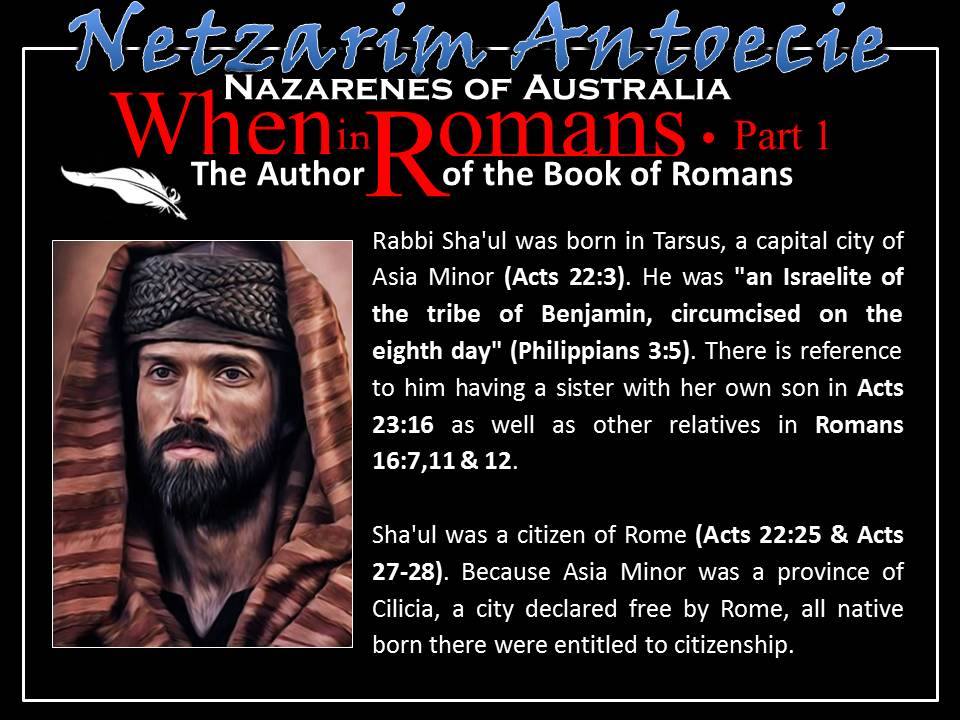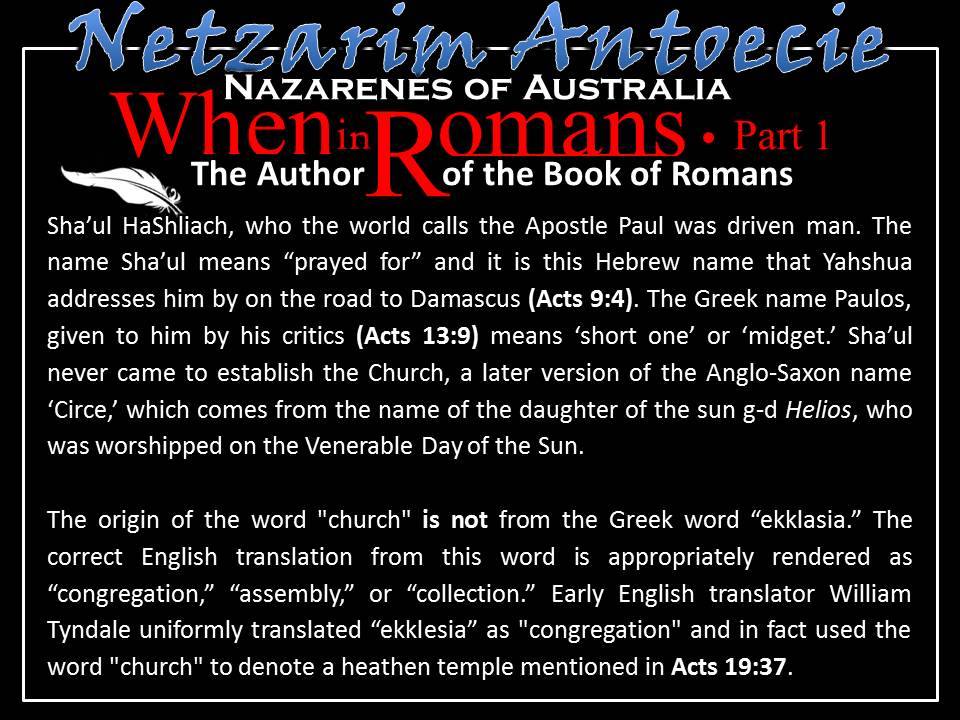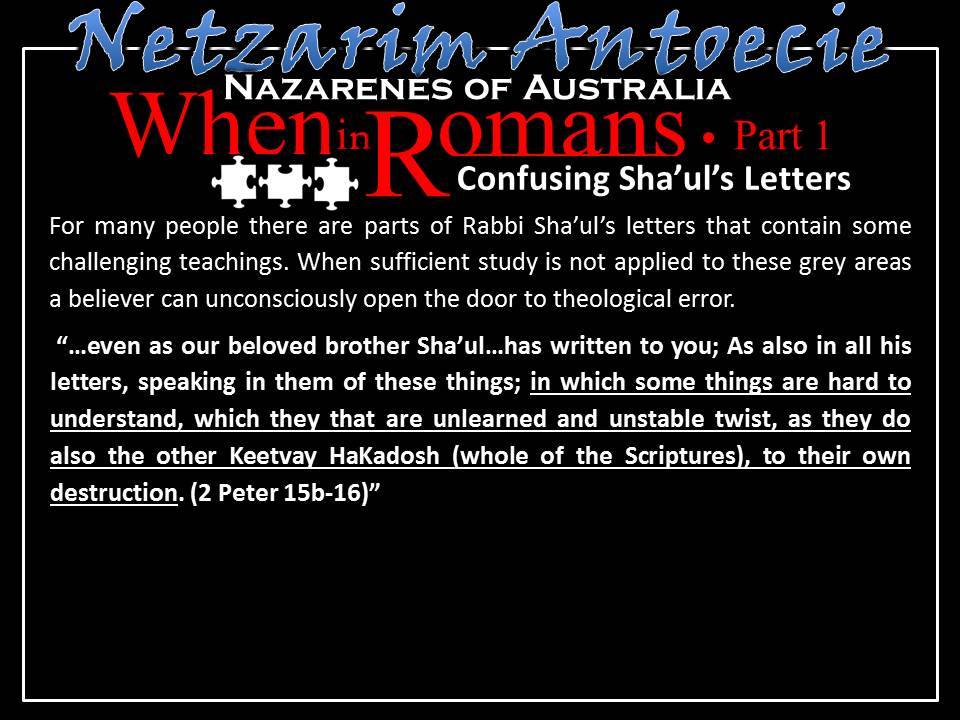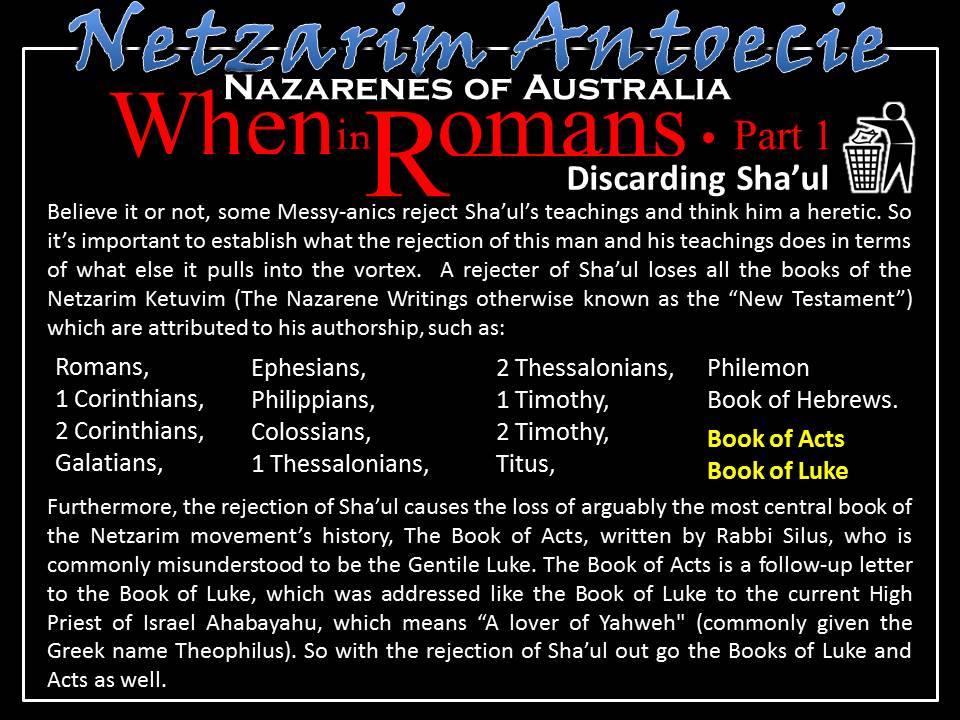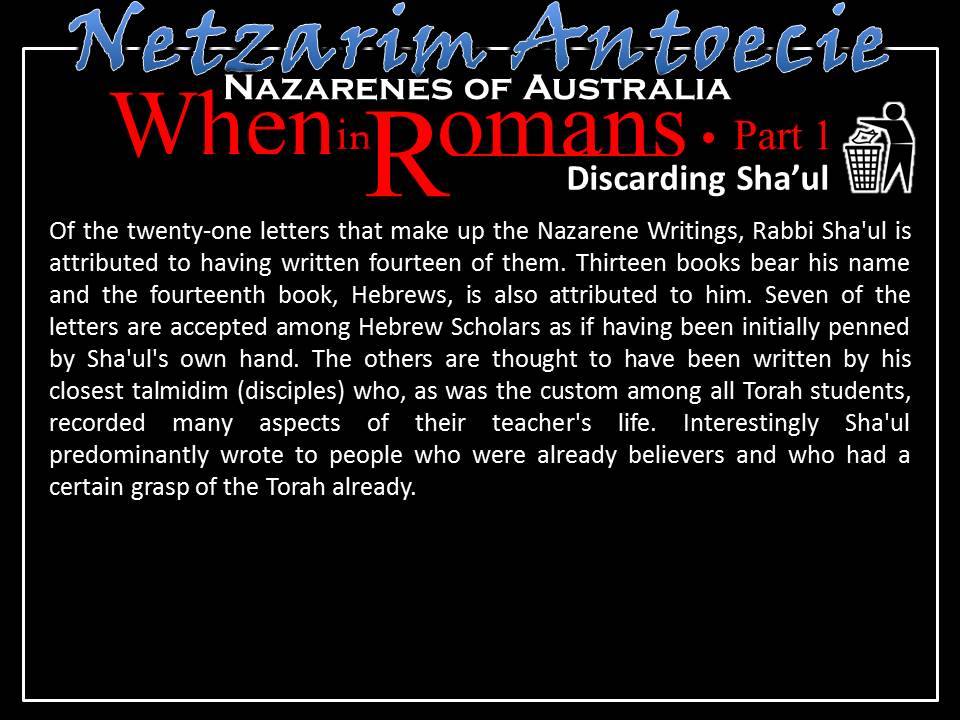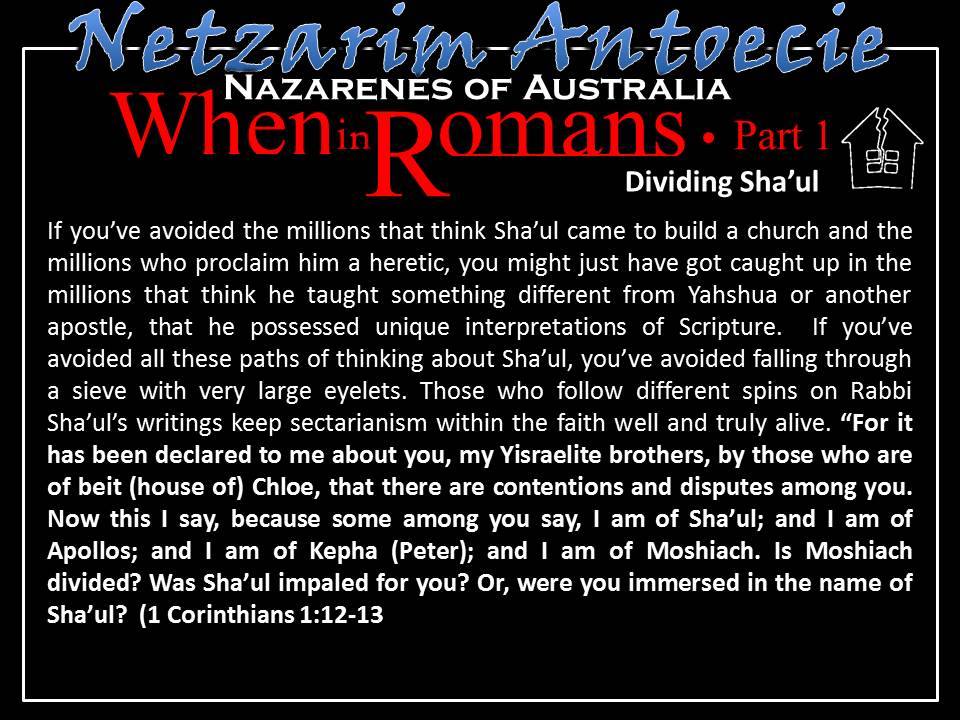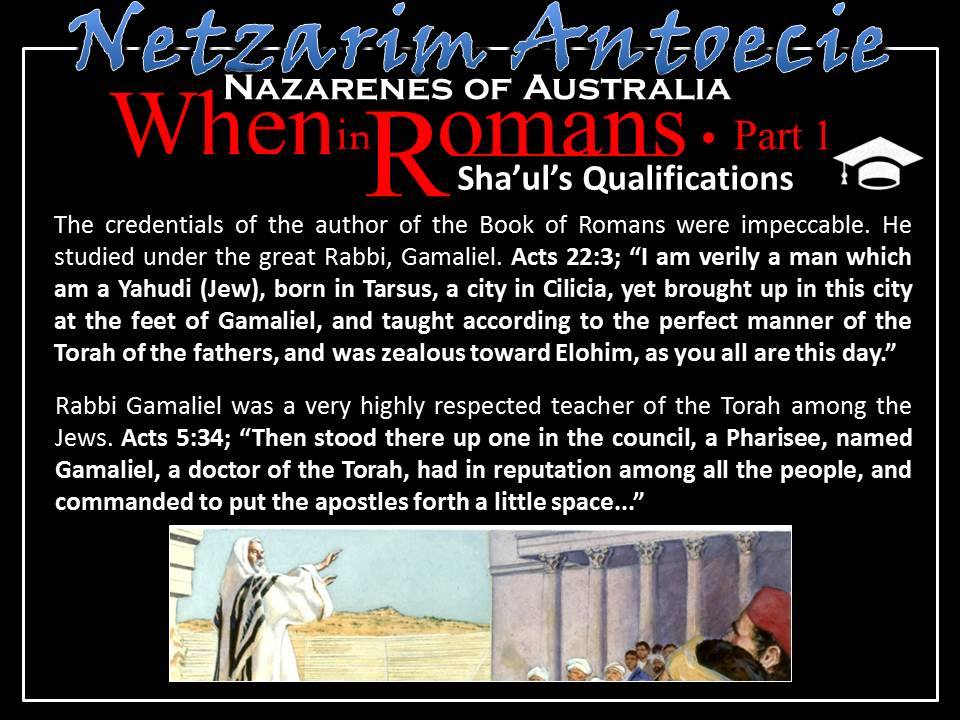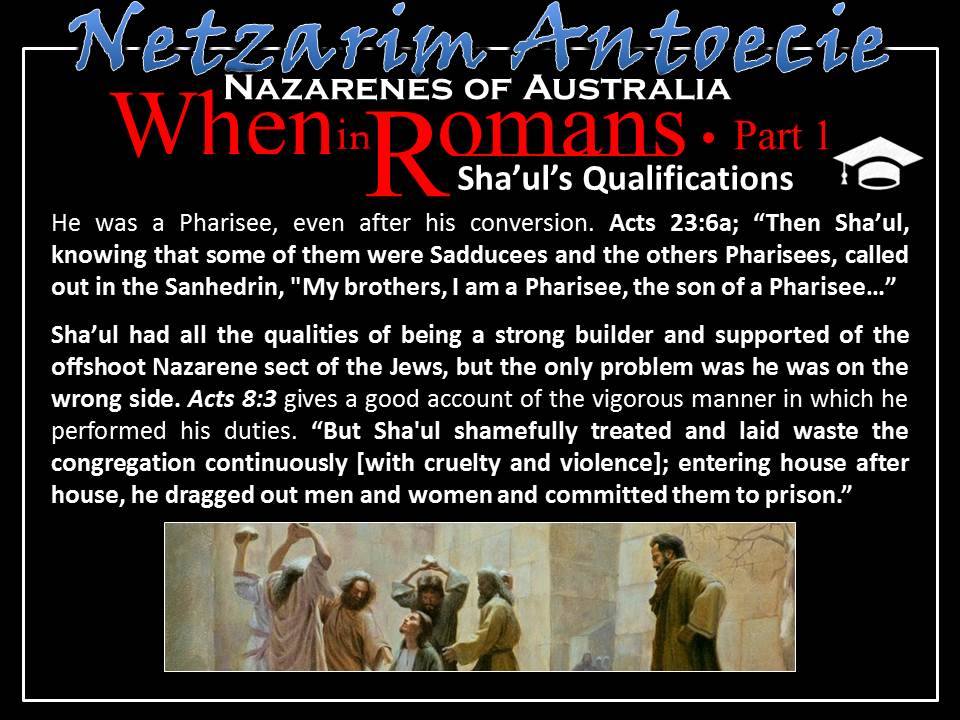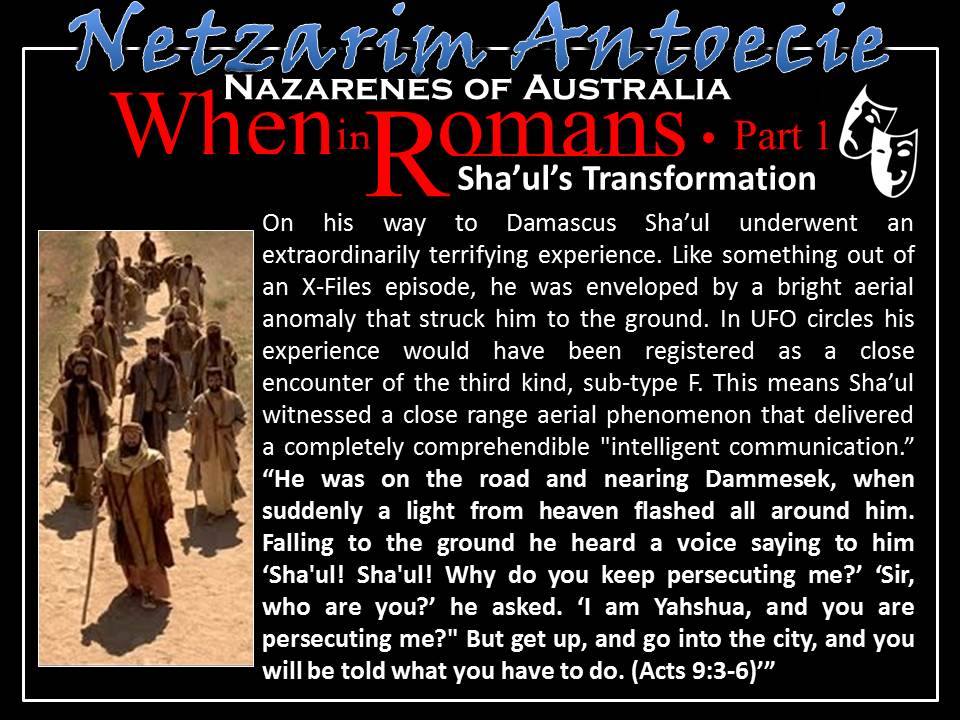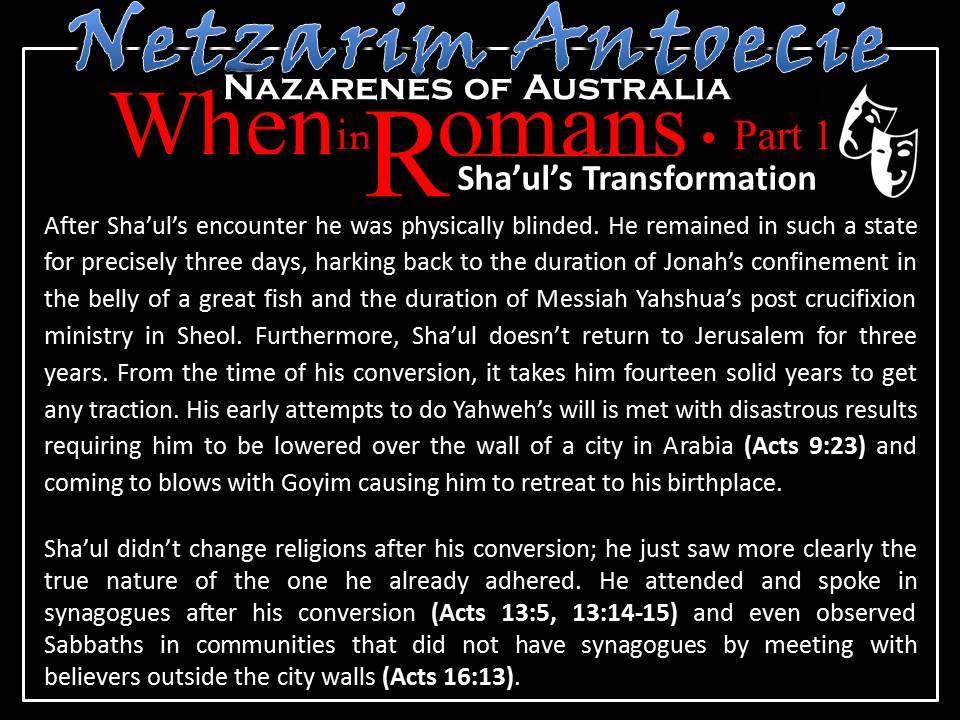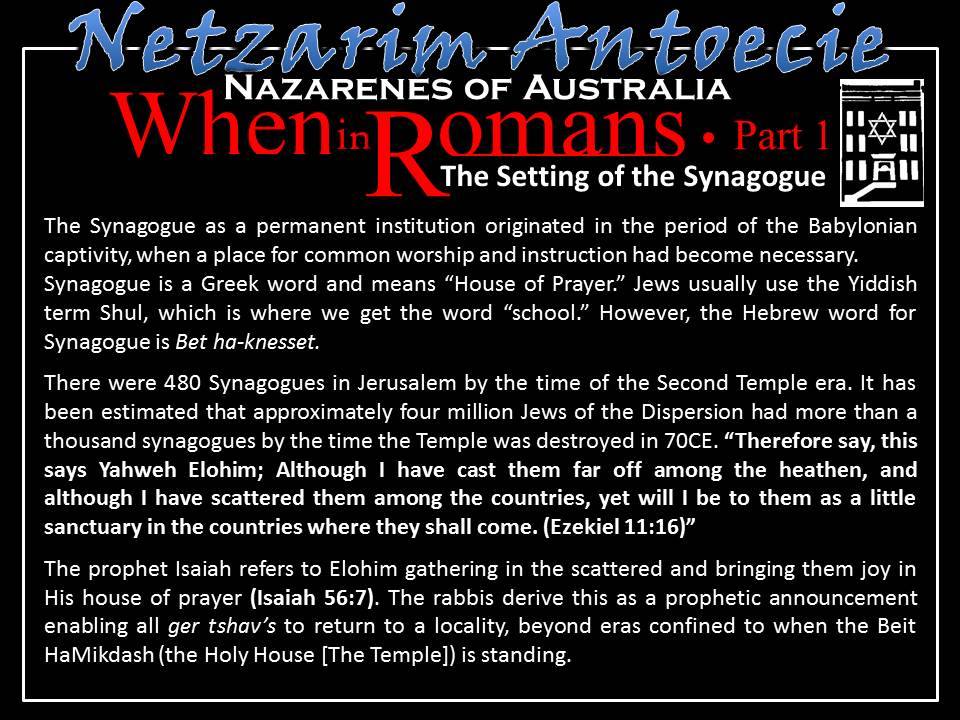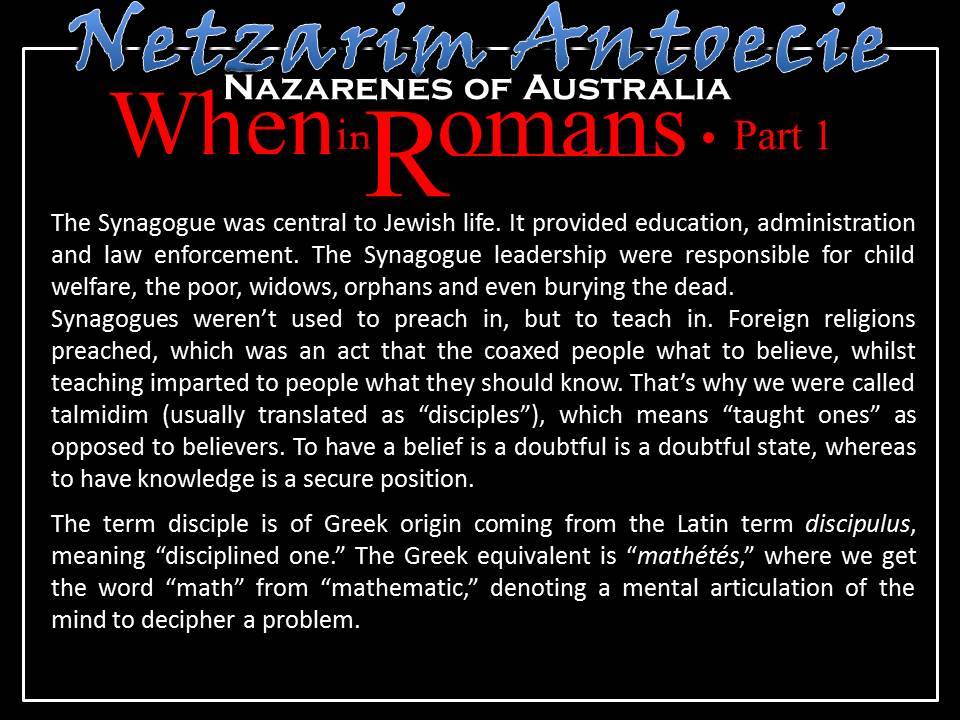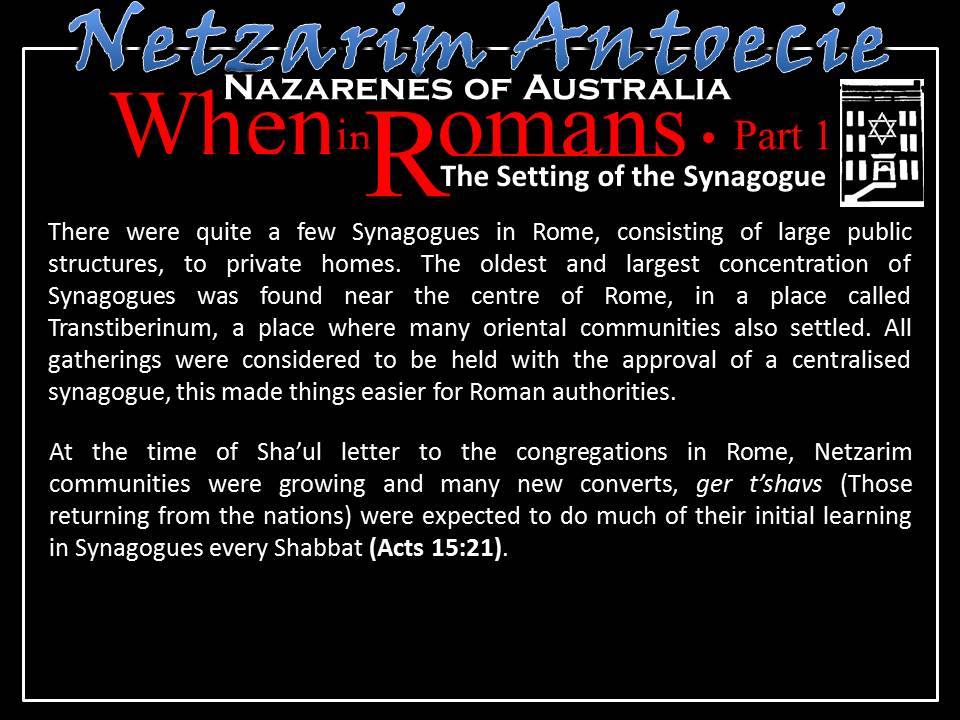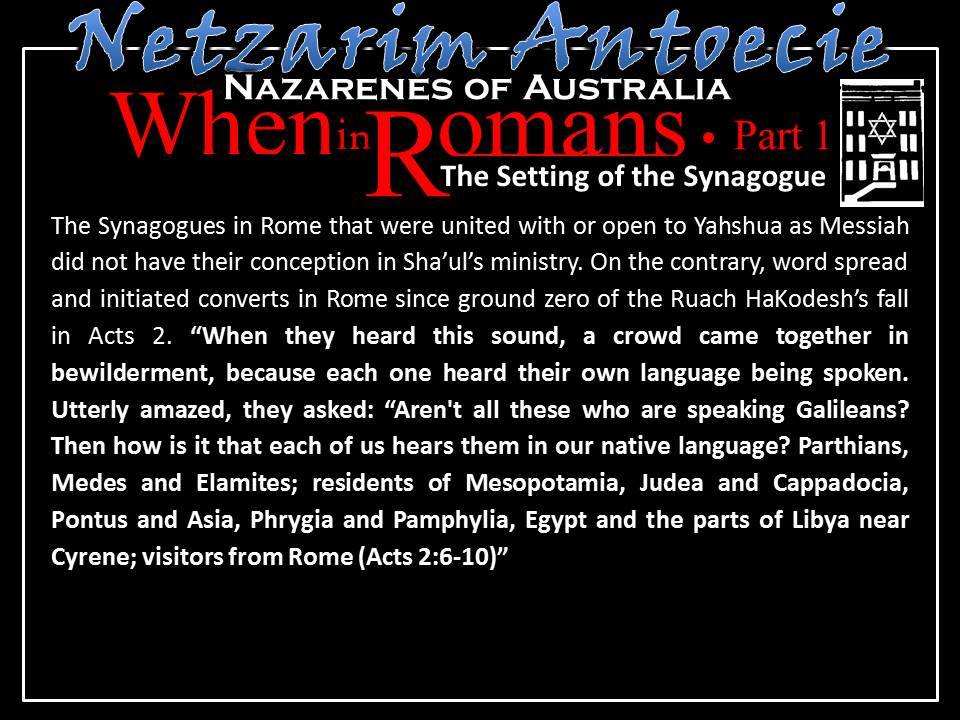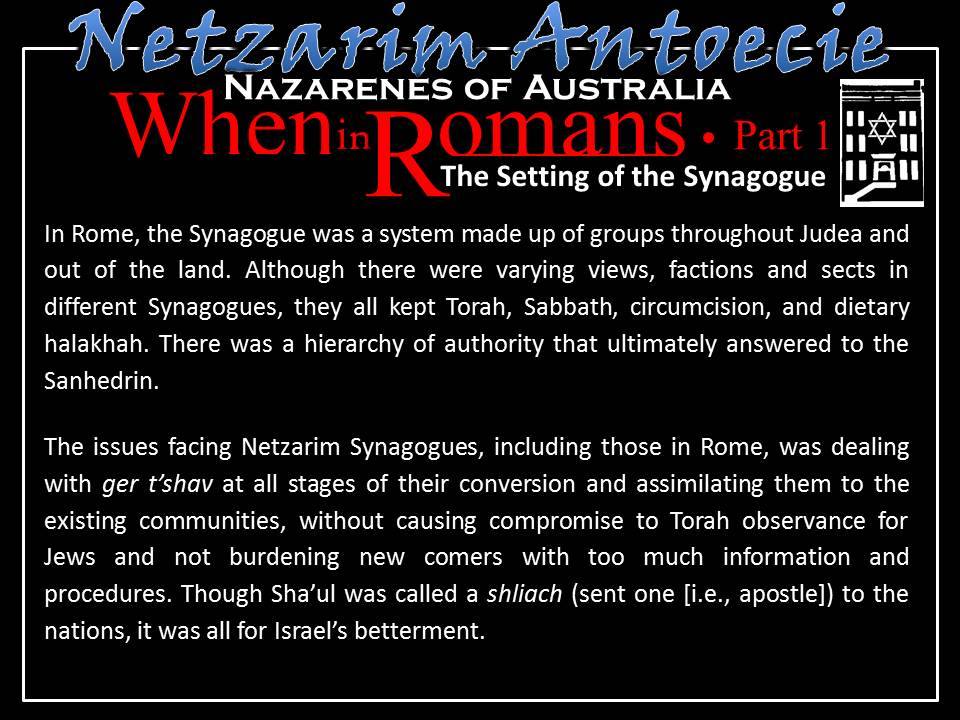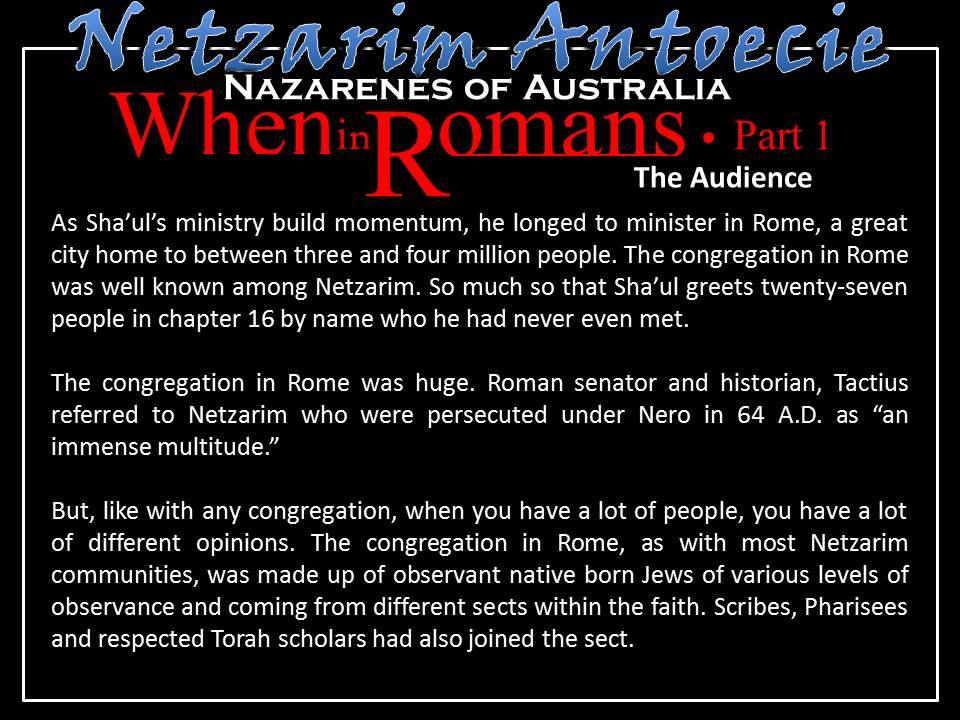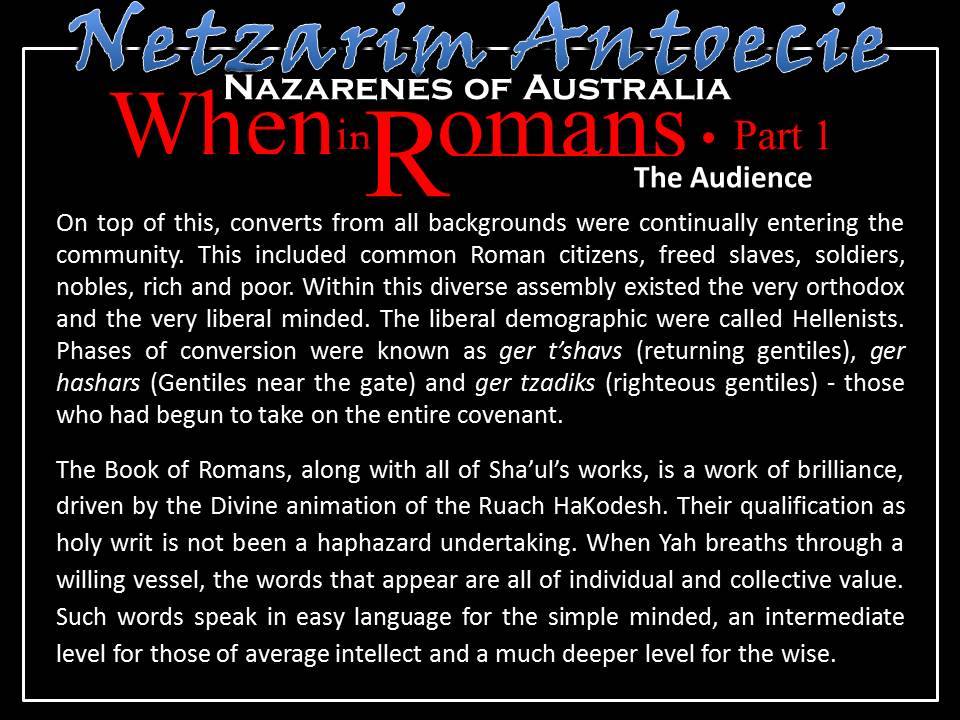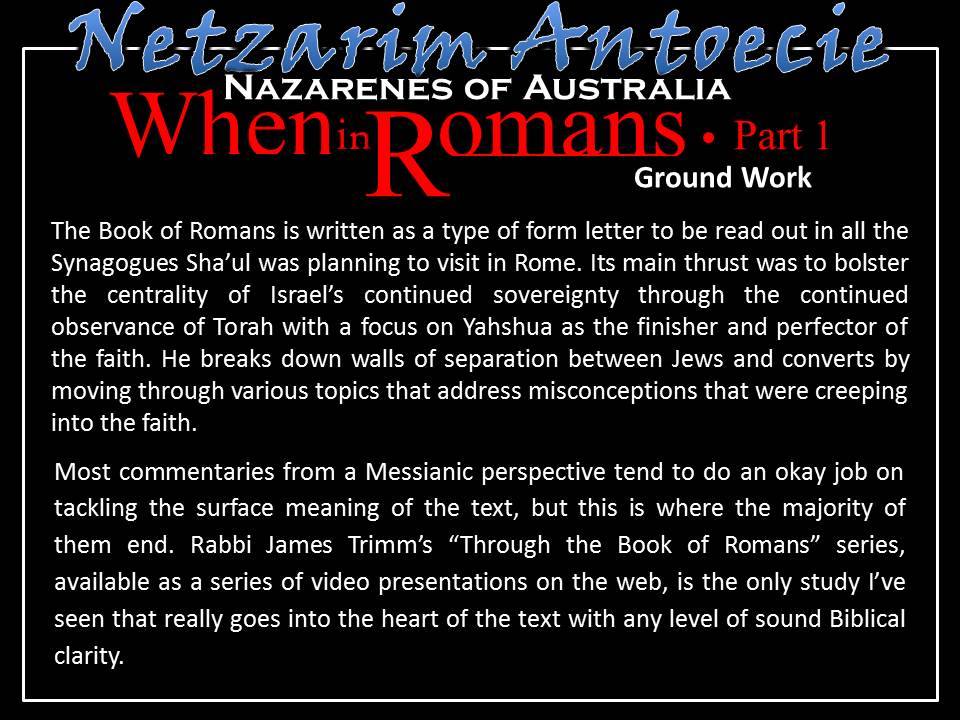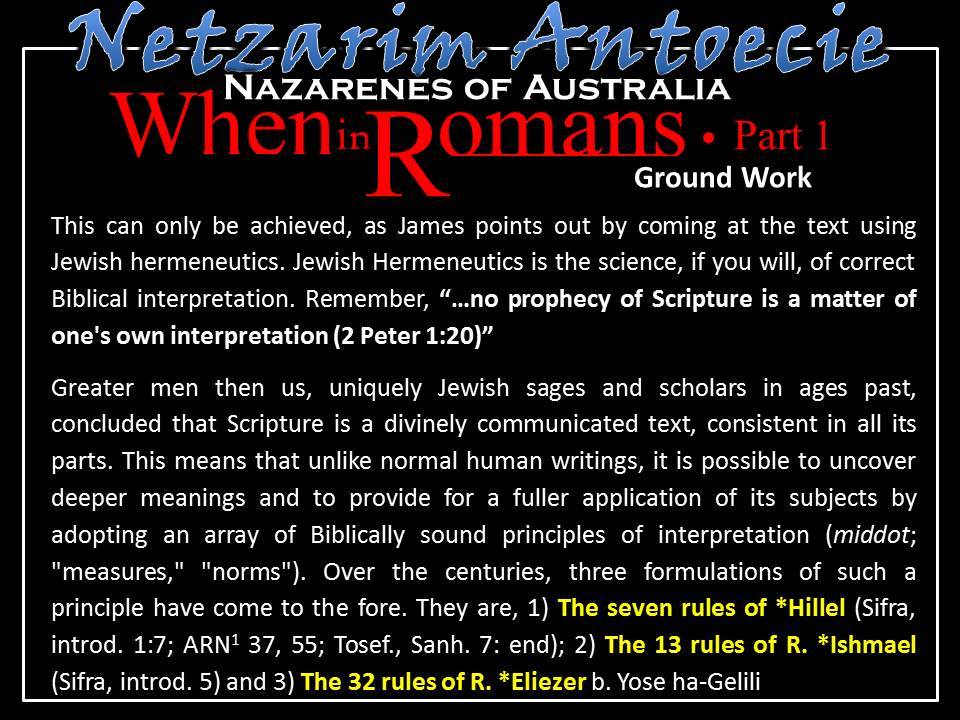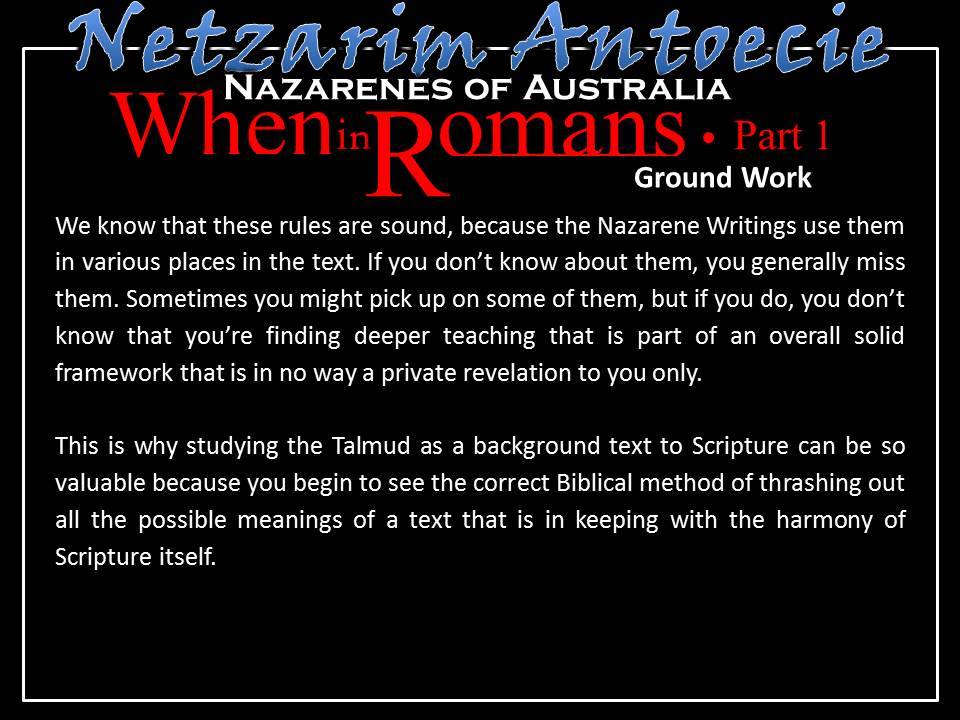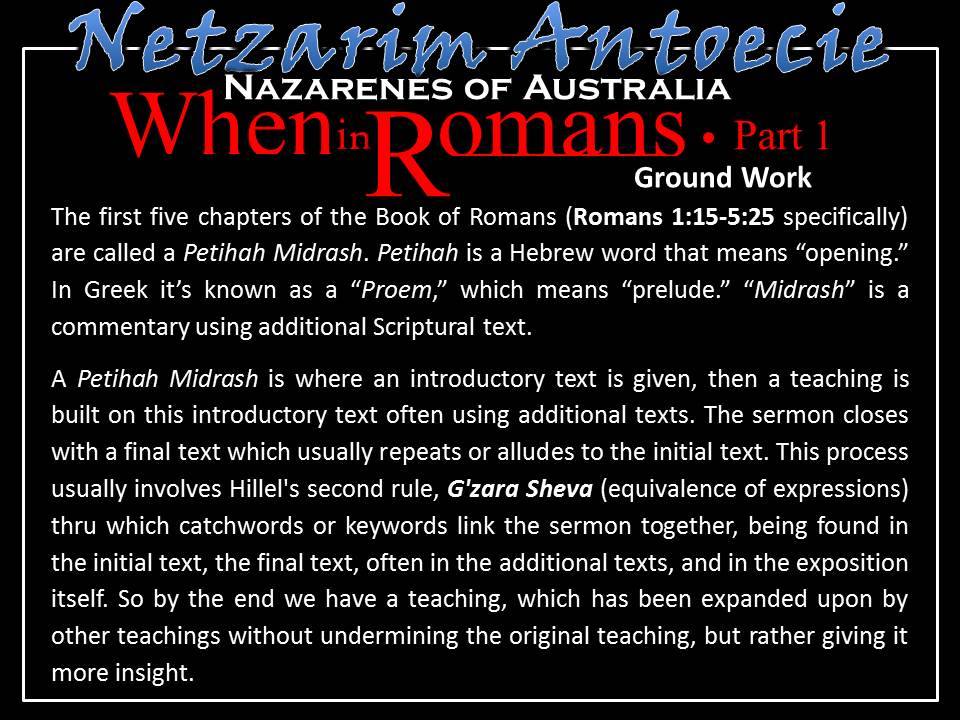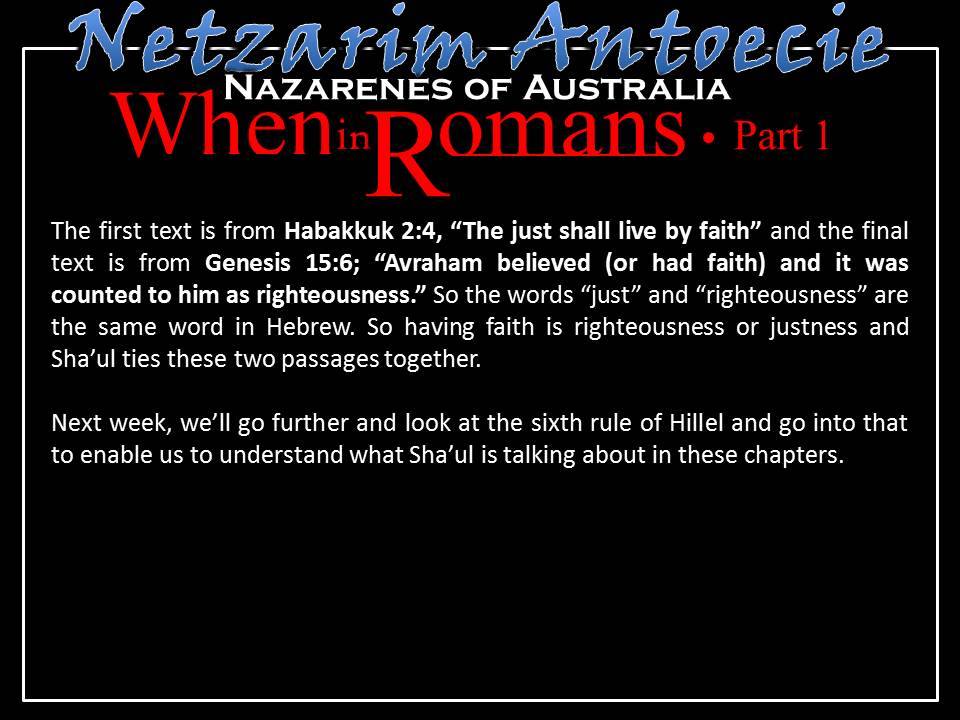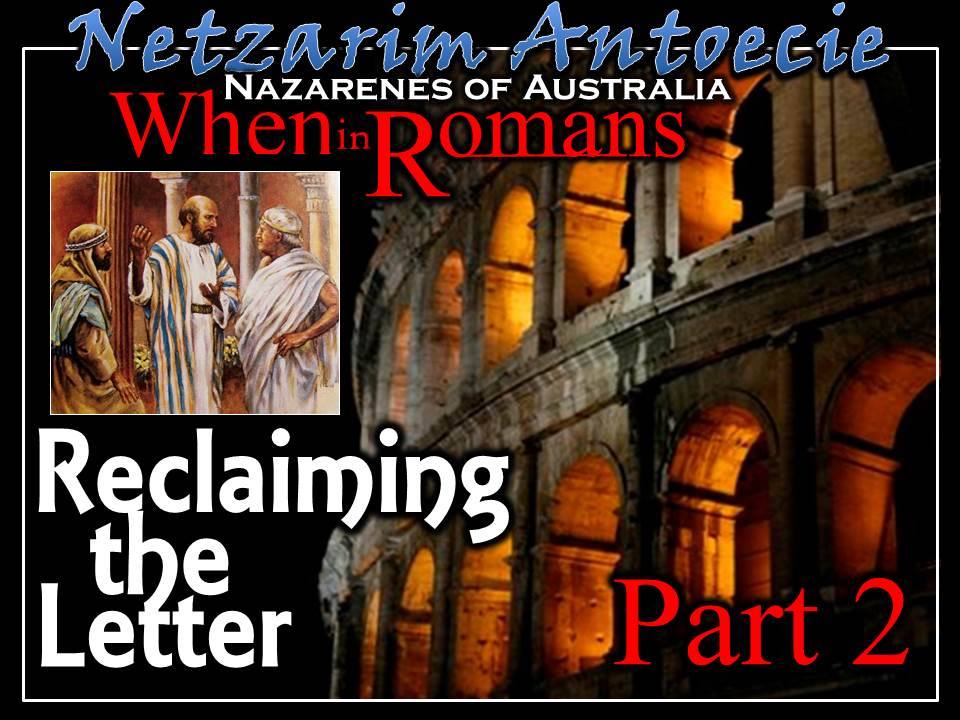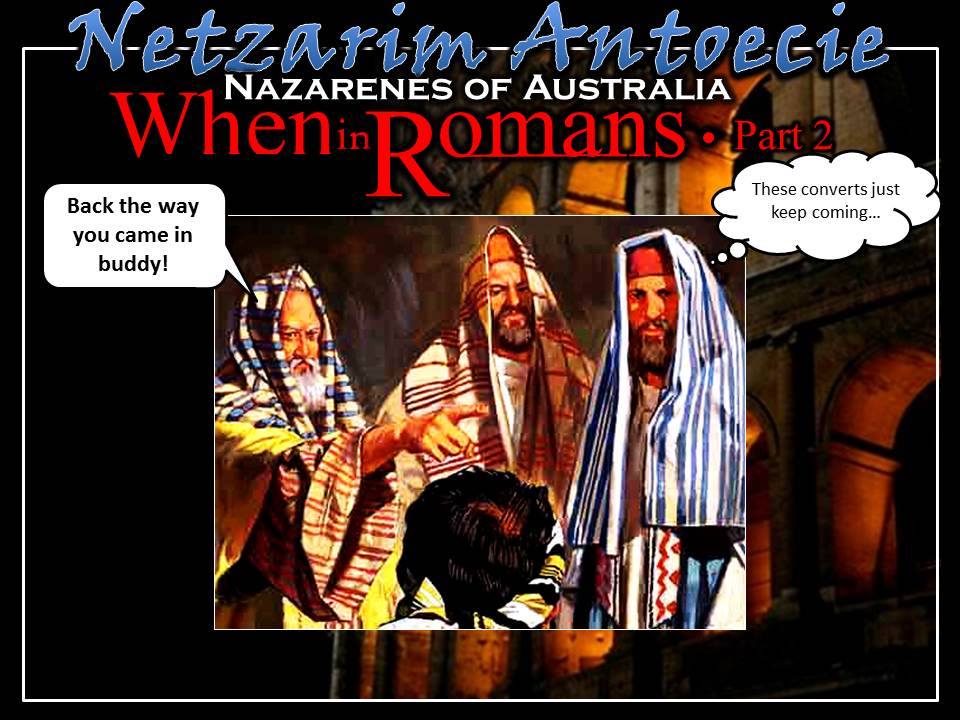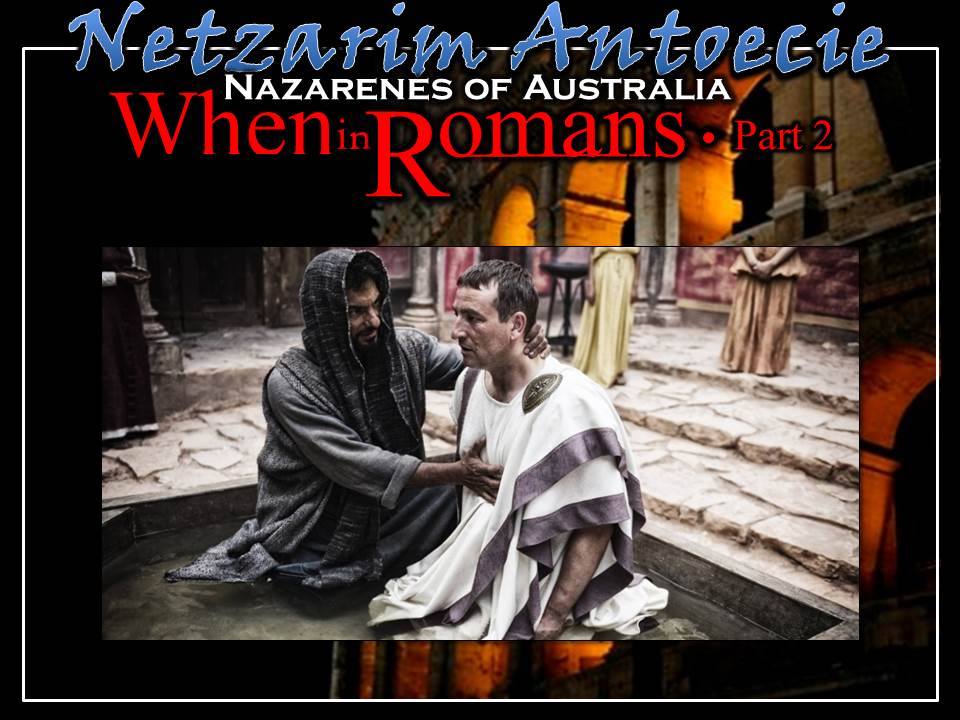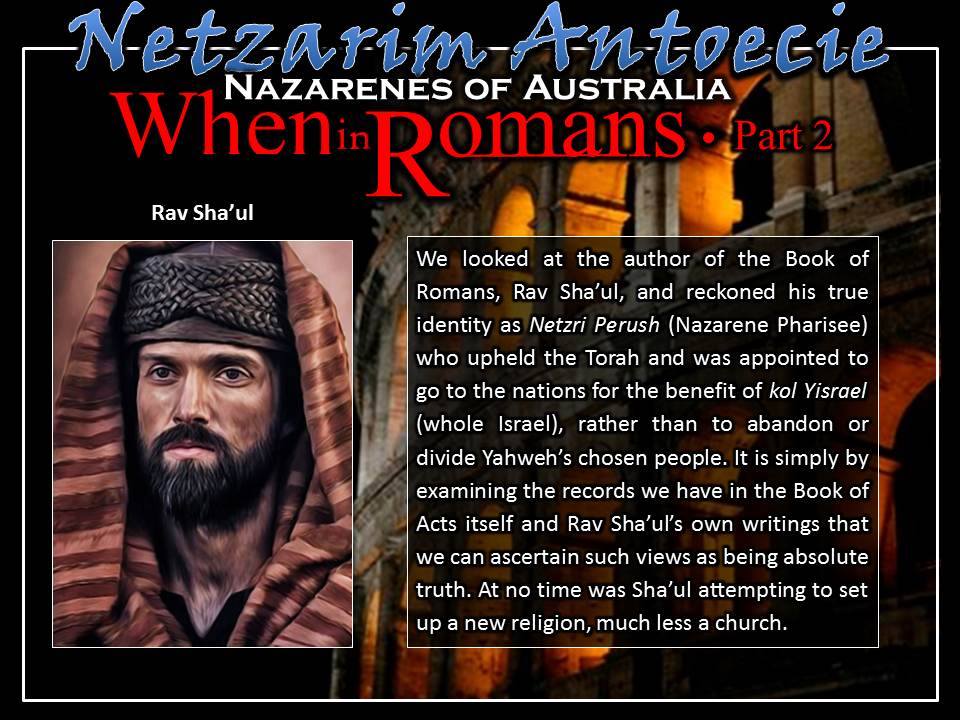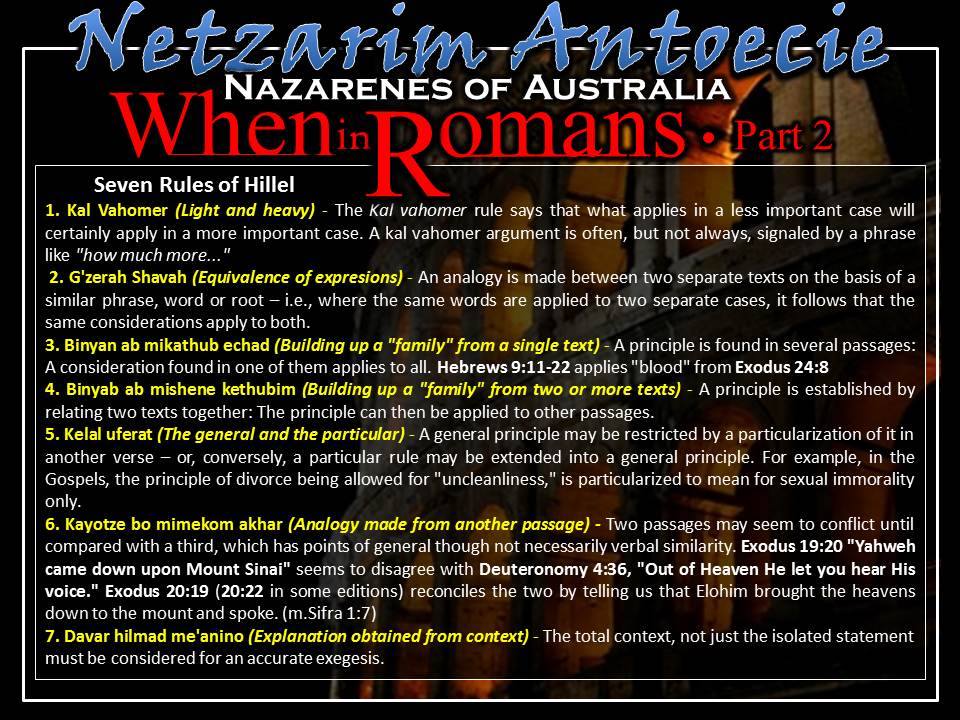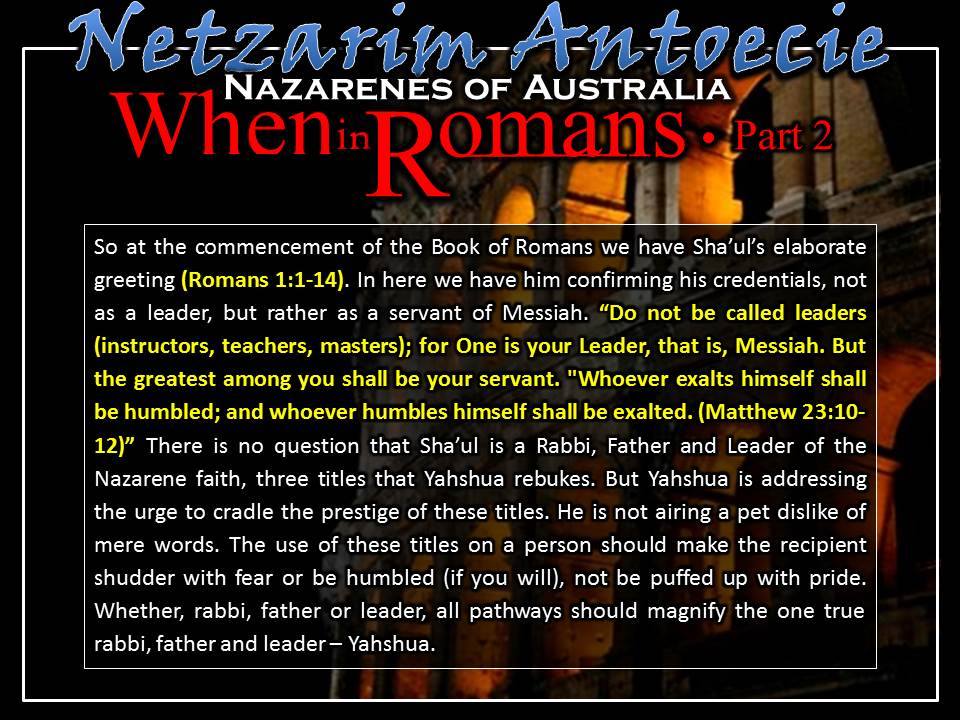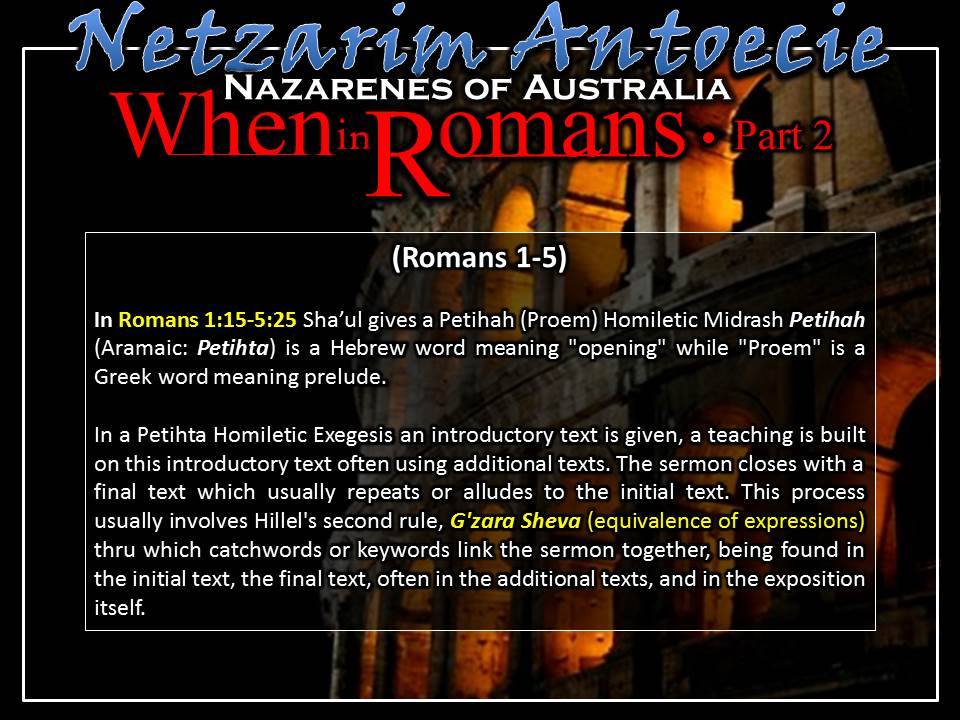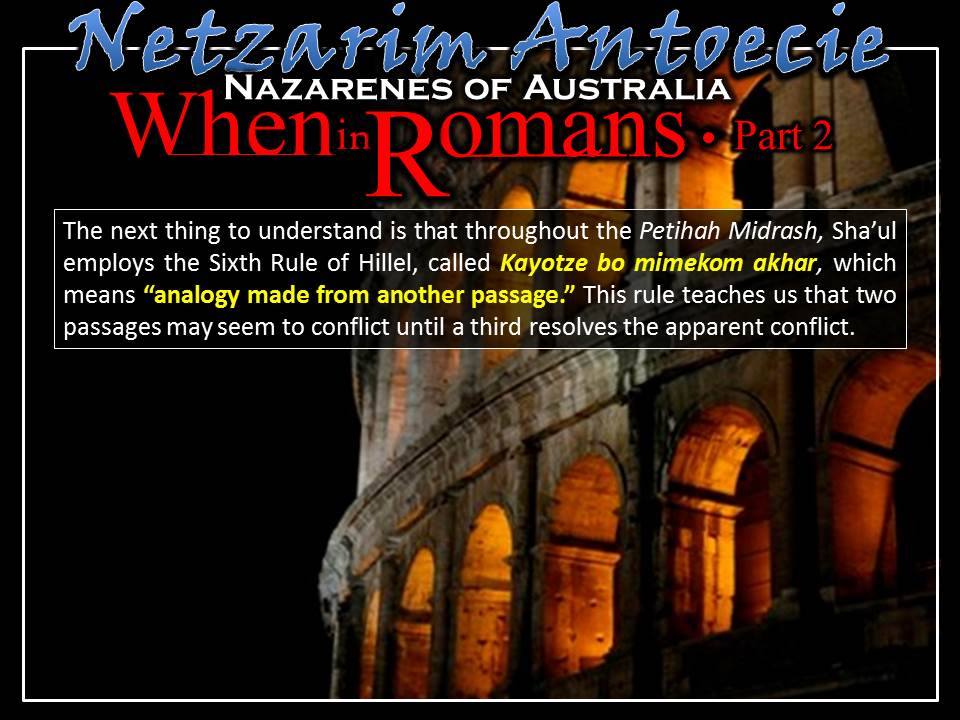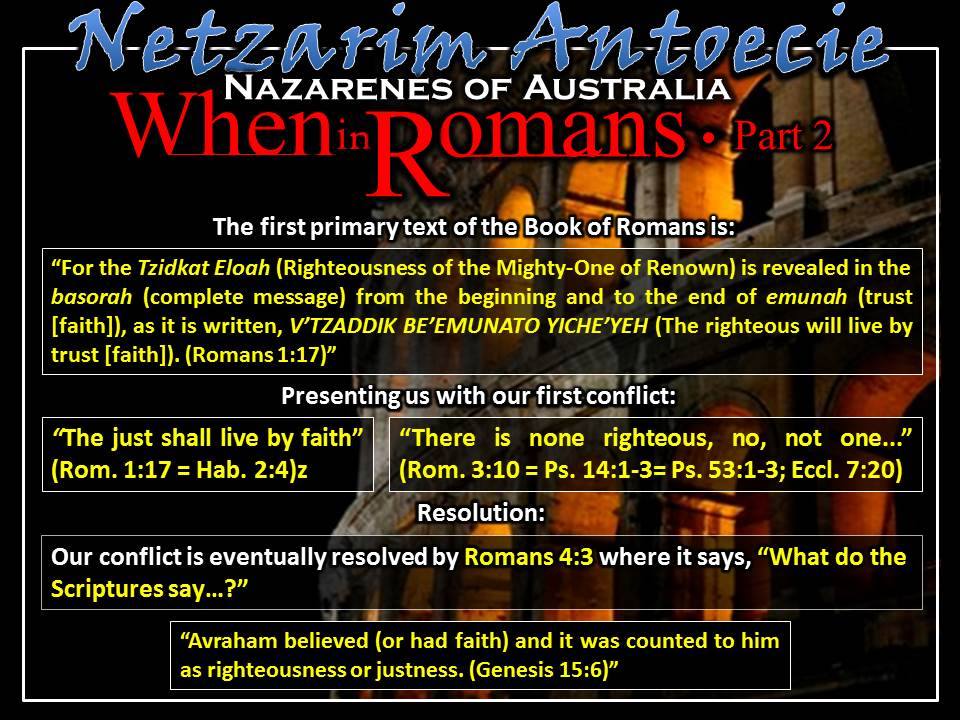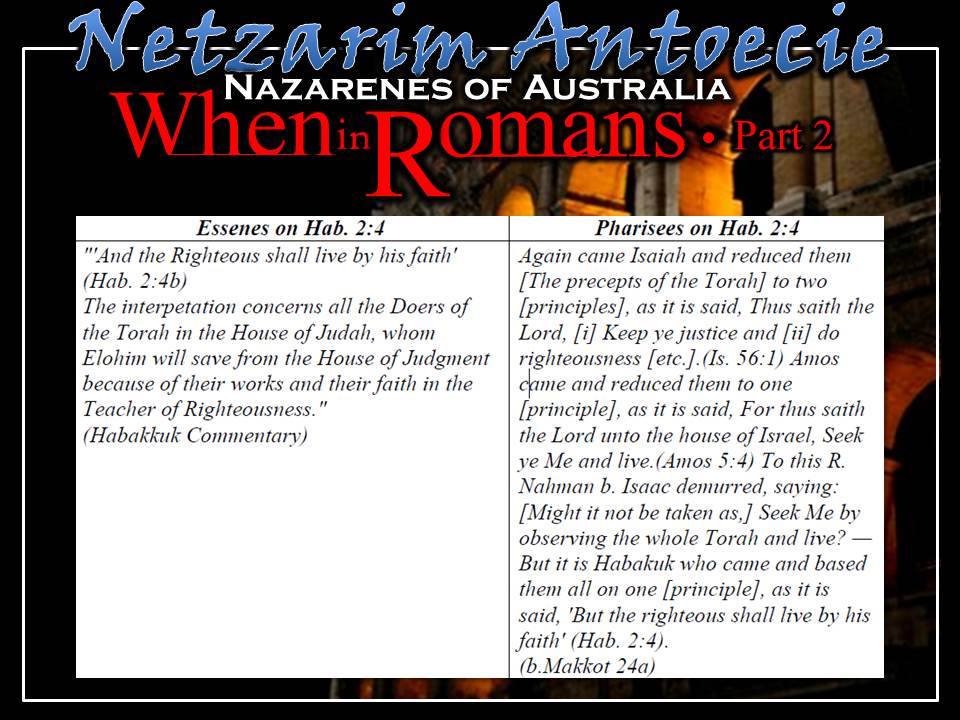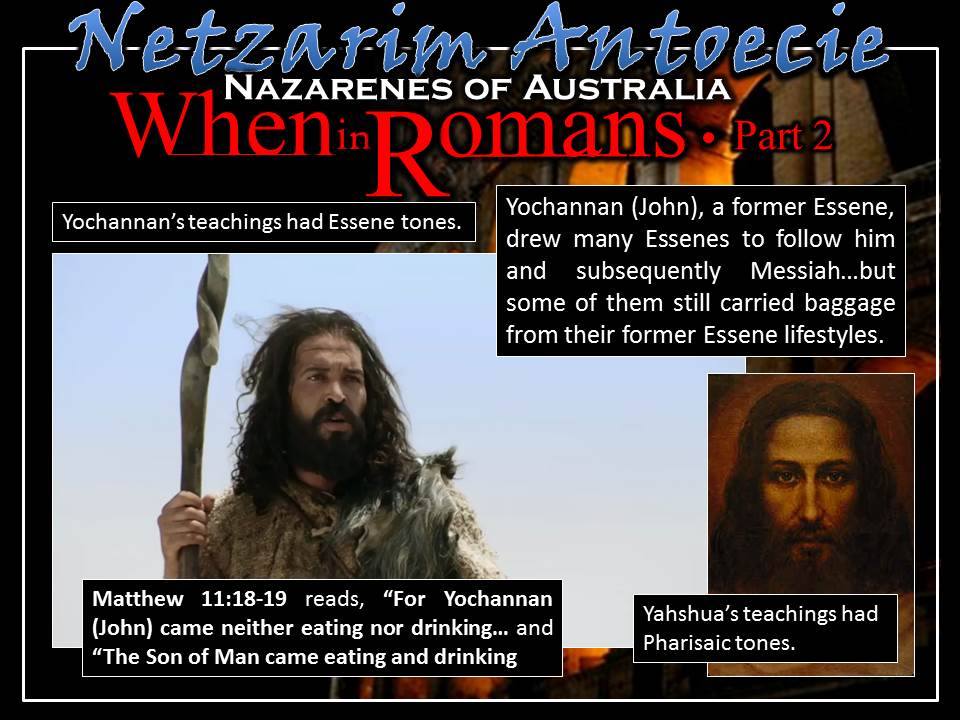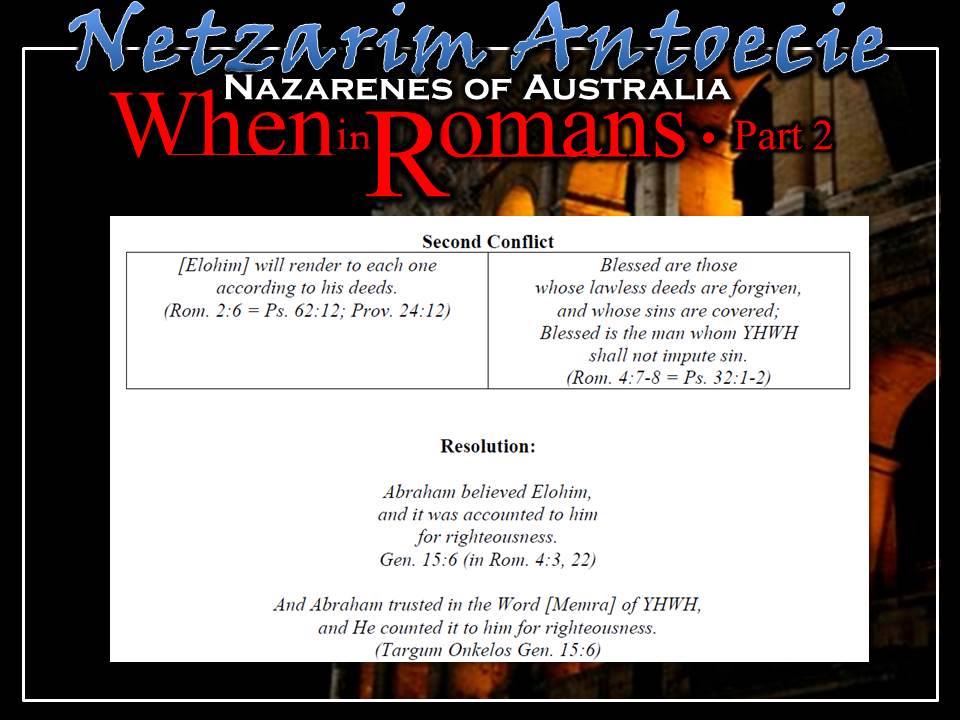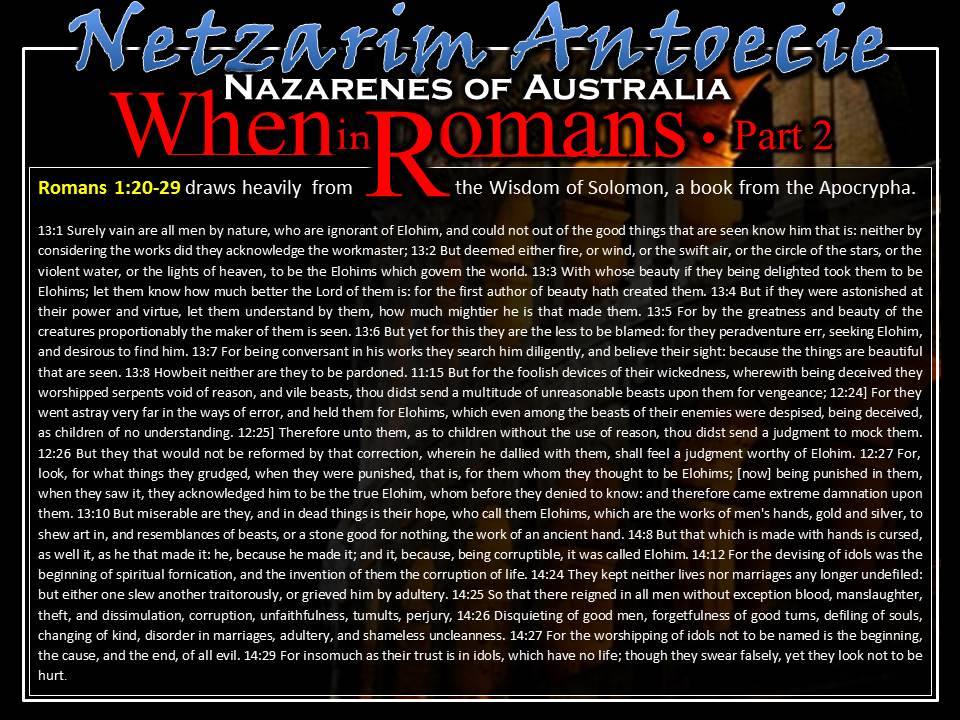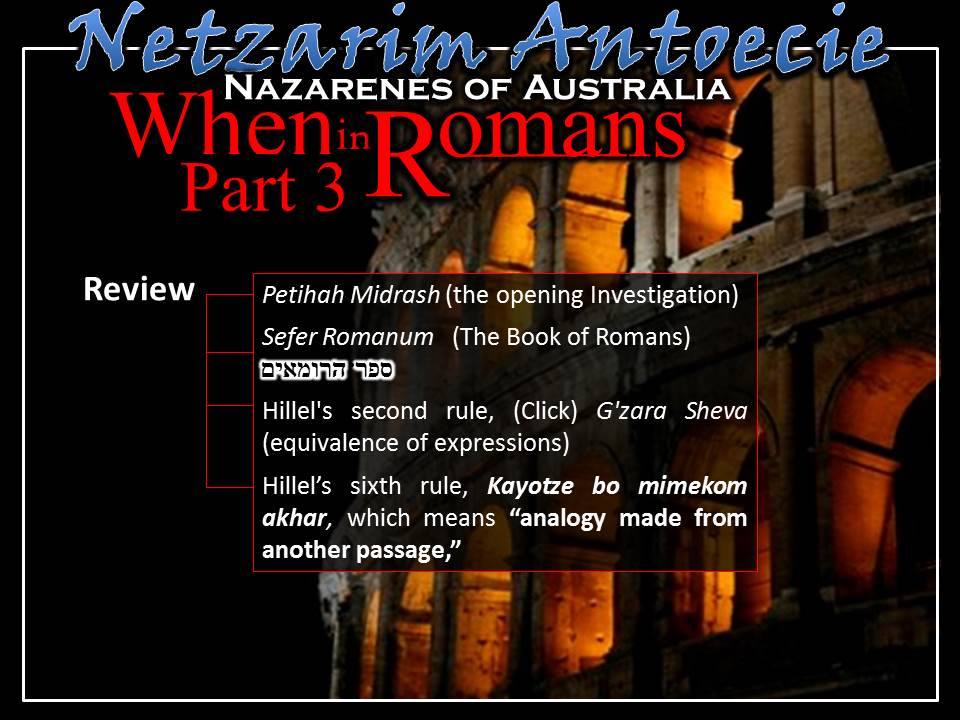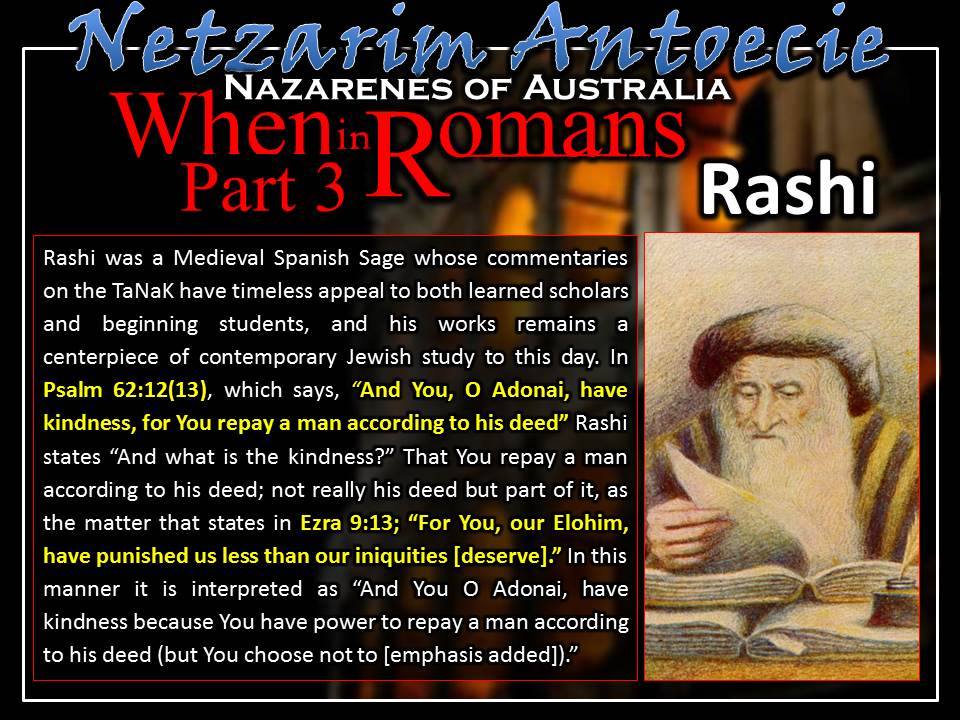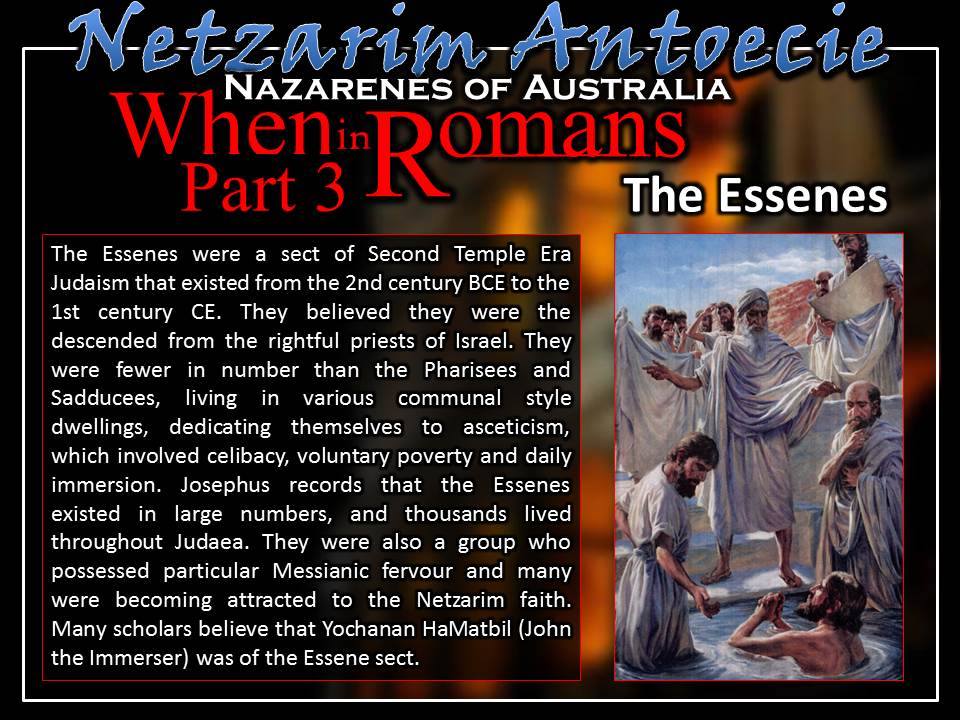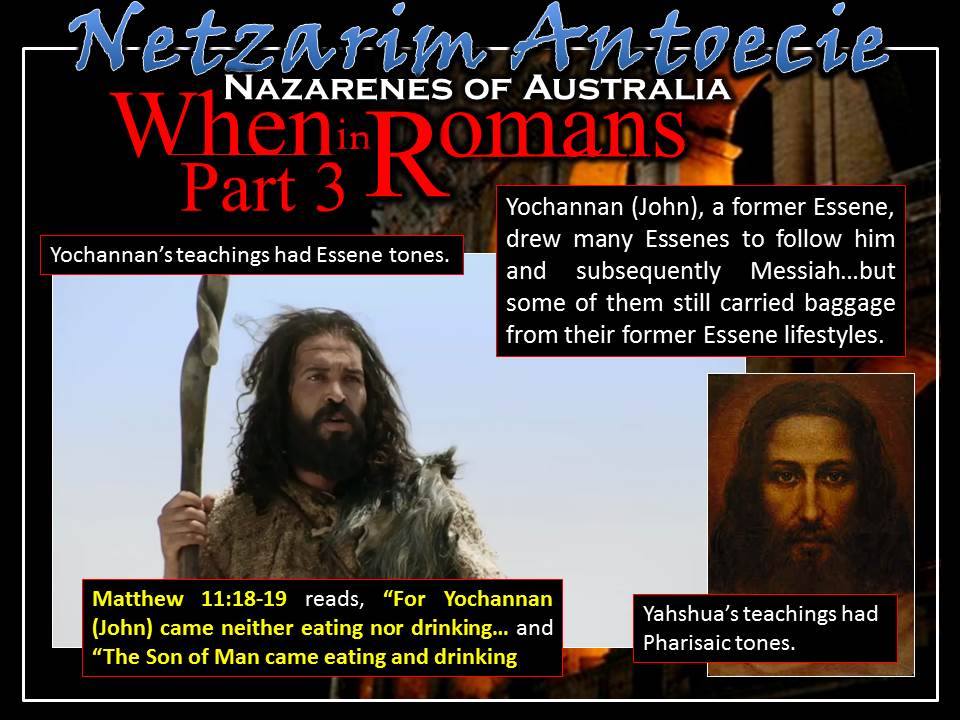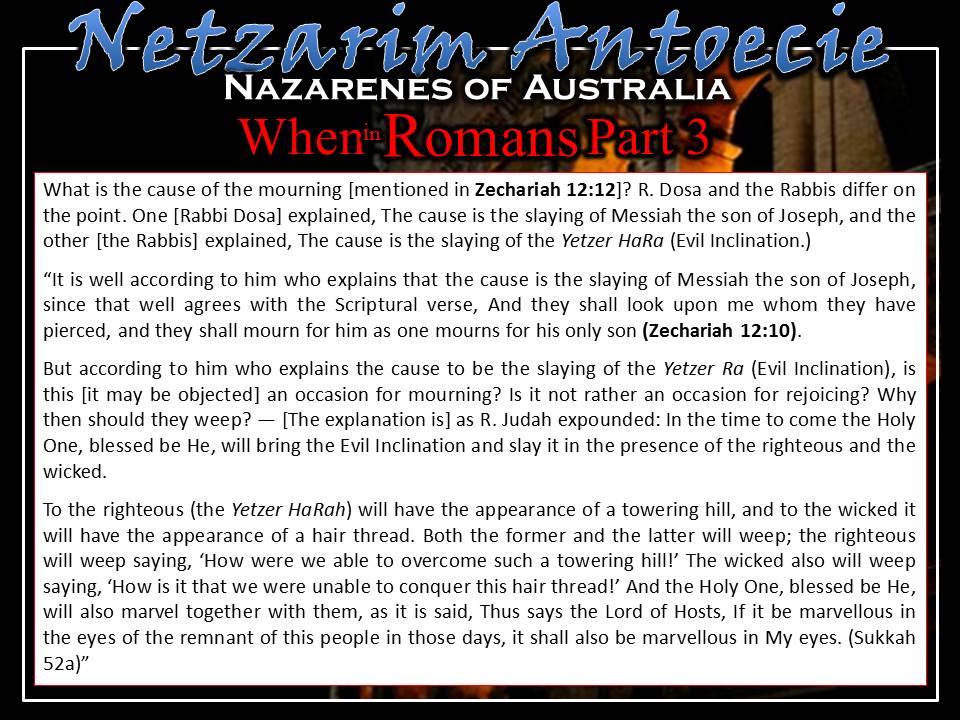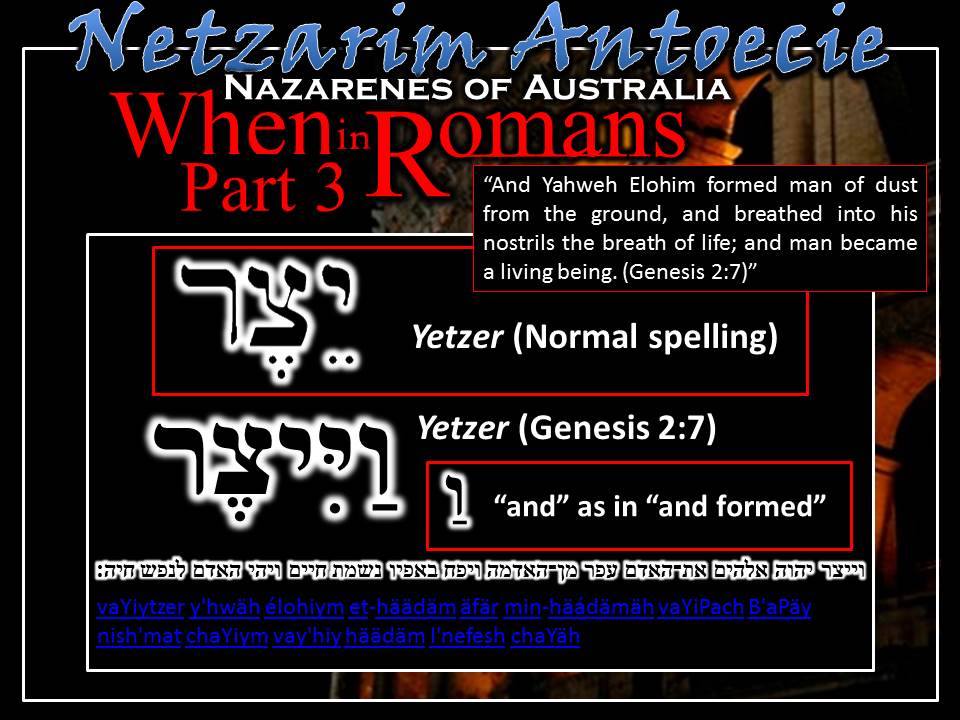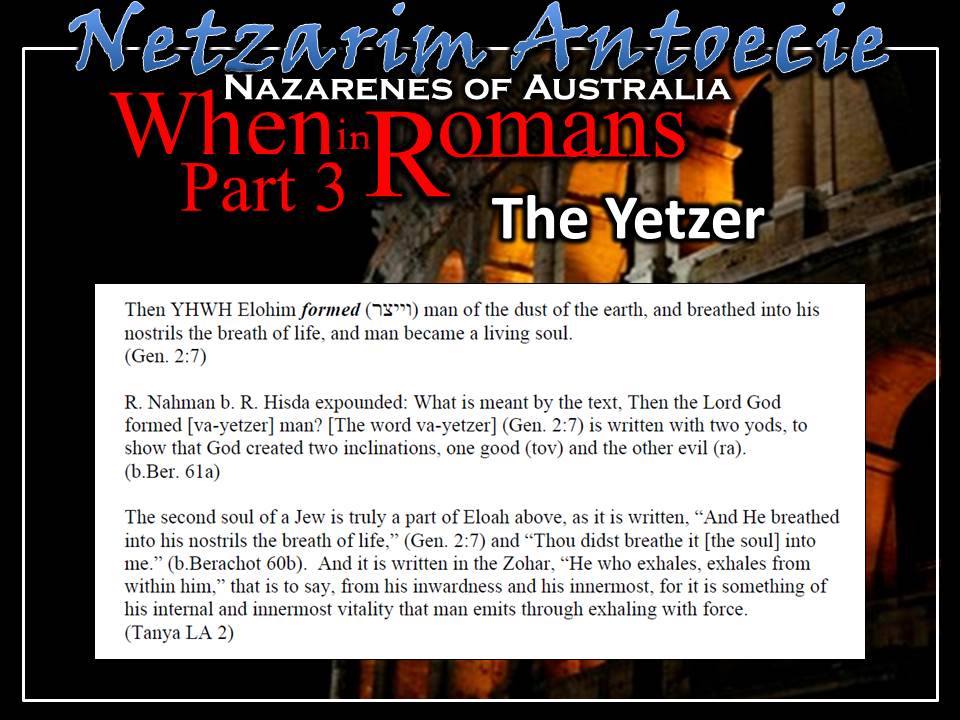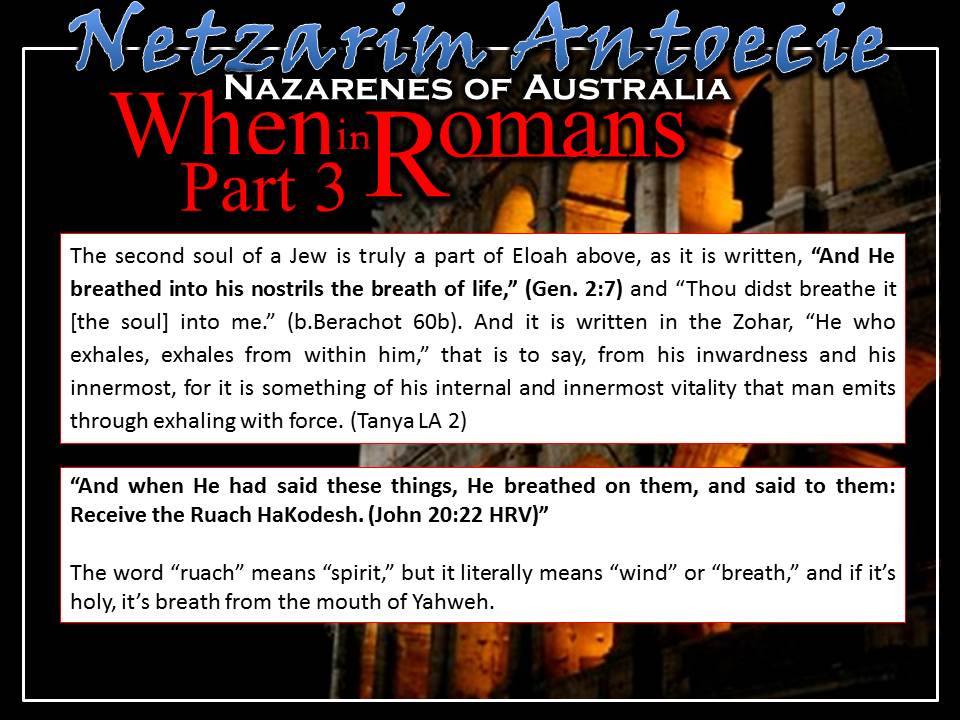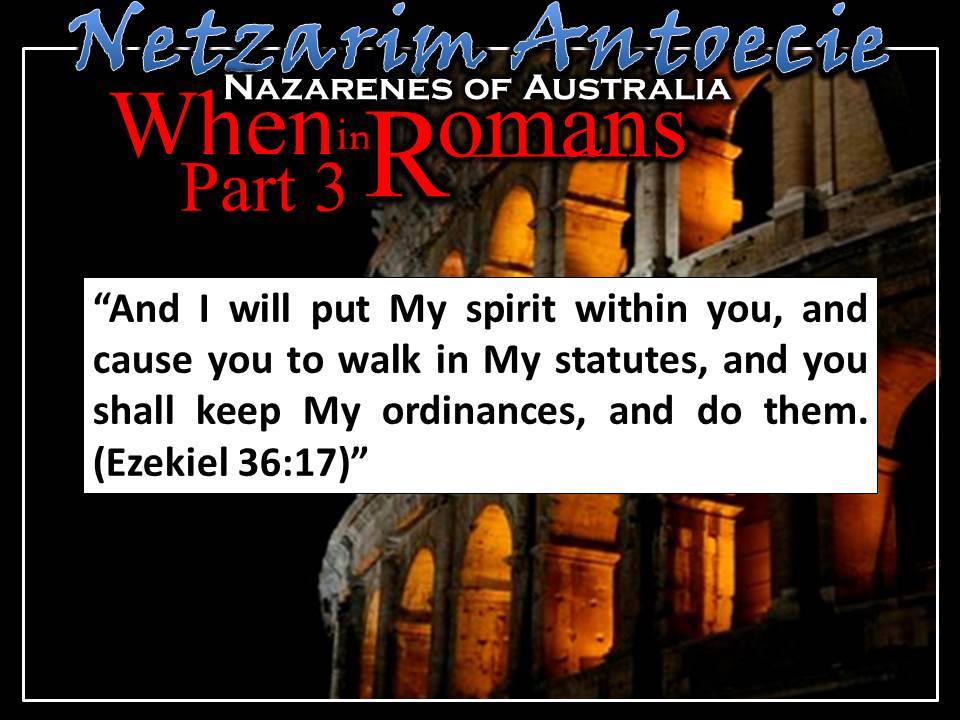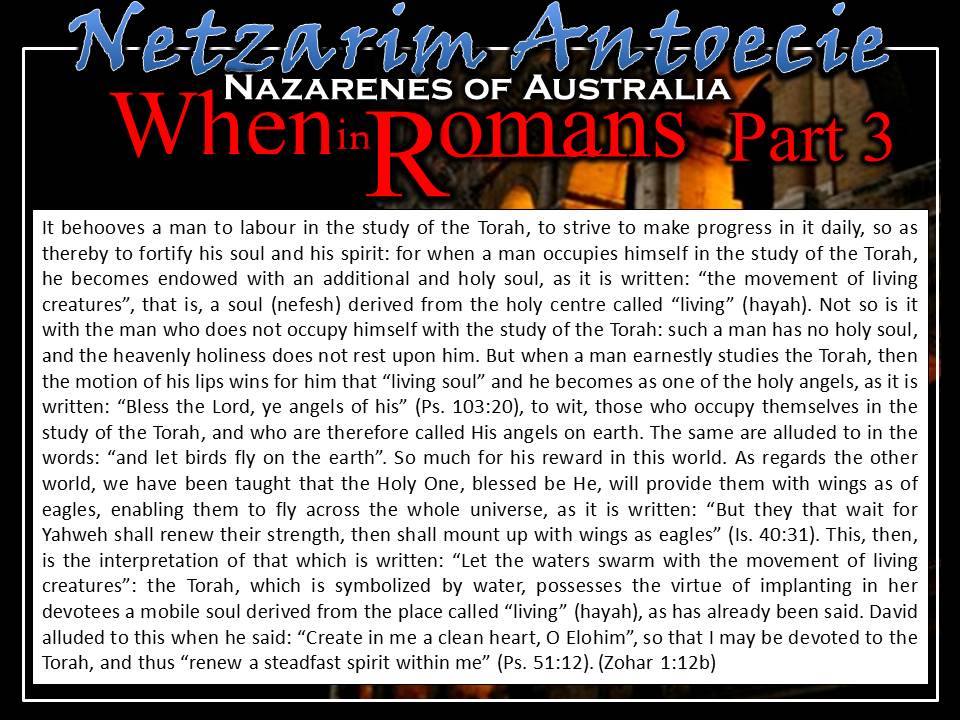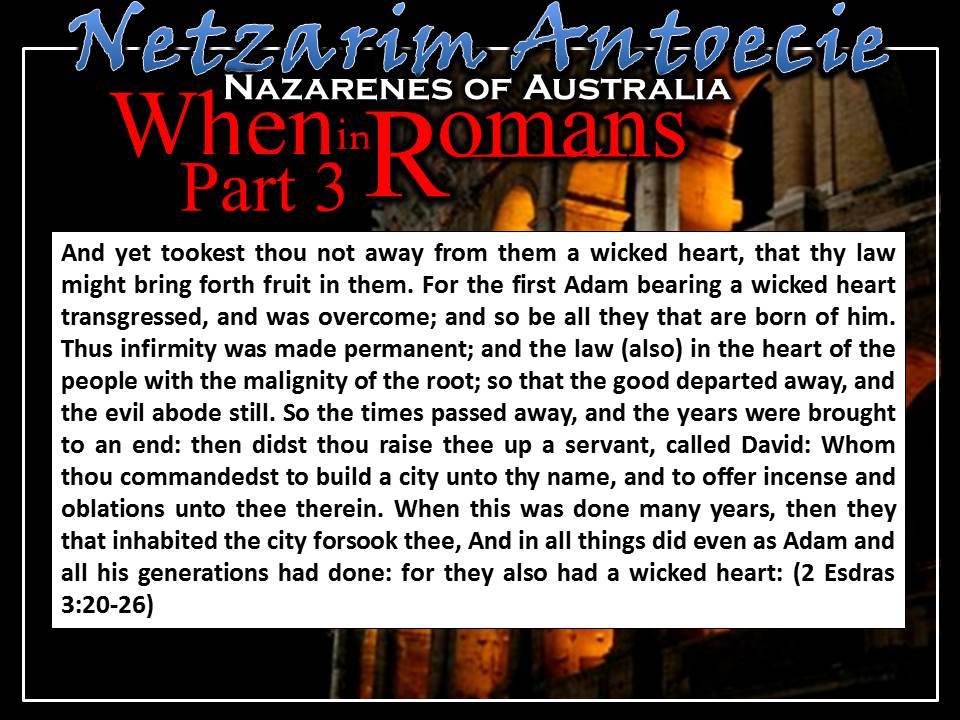When in Romans Teaching by Elder Jason Jordan
When in Romans Part 1
The Author and the Setting of the Book of Romans
Setting the Scene
By the time the Epistle to the congregation in Rome was written, the Romans had occupied Judea for several decades. The Book of Romans was written near the end of Sha’ul’s third phase of ministry in approximately 57CE in Corinth Greece.
The first Emperor of Rome, Julius Caeser, granted Jews legal rights to assemble, have common meals, property, govern, tax and enforce laws particular to their religious and cultural distinctions. This took the form of limited autonomy under the Synagogue and the extension of its legal body, the Sanhedrin. Despite this, the years of foreign occupation and growing Hellenism within second Temple era Judaism had caused much dysfunction and corruption to prevail. So entrenched was this corruption that the handling of the growing Netzarim branch of Judaism might have fared much better in the long run if Judaism had not endured such a rocky road. Having said this, without such a battered climate, the very appearance of Moshiach would have had less validity.
So Judaism received many benefits from Roman, not unlike the benefits it received in Germany before the war. The unique peculiarities of Judaism in contrast to all other pagan religions and the privileges Rome granted the faith became a source of much resentment. Gradually a type of anti-Jewish sentiment among the population came to the fore. Added to this, extremist sects, such as the Zealots, continued to cause harm to their occupiers, leading to a collapse in the relational stability between Rome and the Jews. This culminated in a disastrous revolt and ended with the destruction of the second Temple by 70CE.
Well before this, the existence of a certain level of self-government and legal autonomy can be seen in Sha’ul receiving religious authority to carrying out persecutions against the Netzarim. “Meanwhile, Sha’ul was still breathing out murderous threats against the Adonai’s talmidim. He went to the high priest and asked him for letters to the synagogues in Damascus, so that if he found any there who belonged to the Way, whether men or women, he might take them as prisoners to Jerusalem. (Acts 9:1-2)” Even Sha’ul’s eventual persecution by the Jews adds to this fact. He could not have received lashes or imprisonment had not Jews been allowed to enact their own cultural and religious laws (2 Corinthians 6:3-10; Acts 21:21-26; 32).
It’s interesting to note that Sha’ul was a Roman citizen, which enabled him, if he so chose, to avoid punishment by the Jews. But this would have forfeited his right to speak and teach in the Synagogue and barred him from the Temple precincts. As it was, he only reveals his citizenship to his Roman captors (Acts 22:25).
The Author of the Book of Romans
Rabbi Sha'ul was born in Tarsus, a capital city of Asia Minor (Acts 22:3). He was "an Israelite of the tribe of Benjamin, circumcised on the eighth day" (Philippians 3:5). There is reference to him having a sister with her own son in Acts 23:16 as well as other relatives in Romans 16:7,11 & 12.
Sha'ul was a citizen of Rome (Acts 22:25 & Acts 27-28). Because Asia Minor was a province of Cilicia, a city declared free by Rome, all native born there were entitled to citizenship.
Sha’ul HaShliach, who the world calls the Apostle Paul was a driven man. The name Sha’ul means “prayed for” and it is this Hebrew name that Yahshua addresses him by on the road to Damascus (Acts 9:4). The Greek name Paulos, given to him by his critics (Acts 13:9) means ‘short one’ or ‘midget.’ Sha’ul never came to establish the Church, a later version of the Anglo-Saxon name ‘Circe,’ which comes from the name of the daughter of the sun g-d Helios, who was worshipped on the Venerable Day of the Sun.
The origin of the word "church" is not from the Greek word “ekklasia.” The correct English translation from this word is appropriately rendered as “congregation,” “assembly,” or “collection.” Early English translator William Tyndale uniformly translated “ekklesia” as "congregation" and in fact used the word "church" to denote a heathen temple mentioned in Acts 19:37.
For many people there are parts of Rabbi Sha’ul’s letters that contain some challenging teachings. When sufficient study is not applied to these grey areas a believer can unconsciously open the door to theological error.
“…even as our beloved brother Sha’ul…has written to you; As also in all his letters, speaking in them of these things; in which some things are hard to understand, which they that are unlearned and unstable twist, as they do also the other Keetvay HaKadosh (whole of the Scriptures), to their own destruction. (2 Peter 15b-16)”
Believe it or not, some Messy-anics reject Sha’ul’s teachings and think him a heretic. So it’s important to establish what the rejection of this man and his teachings does in terms of what else it pulls into the vortex. A rejecter of Sha’ul loses all the books of the Netzarim Ketuvim (The Nazarene Writings otherwise known as the “New Testament”) which are attributed to his authorship, such as Romans, 1 Corinthians, 2 Corinthians, Galatians, Ephesians, Philippians, Colossians, 1 Thessalonians, 2 Thessalonians, 1 Timothy, 2 Timothy, Titus, Philemon and the Book of Hebrews. Furthermore, the rejection of Sha’ul causes the loss of arguably the most central book of the Netzarim movement’s history, The Book of Acts, written by Rabbi Silus, who is commonly misunderstood to be the Gentile Luke. The Book of Acts is a follow-up letter to the Book of Luke, which was addressed like the Book of Luke to the current High Priest of Israel Ahabayahu, which means “A lover of Yahweh" (commonly given the Greek name Theophilus). So with the rejection of Sha’ul out go the Books of Luke and Acts as well.
Of the twenty-one letters that make up the Nazarene Writings, Rabbi Sha'ul is attributed to having written fourteen of them. Thirteen books bear his name and the fourteenth book, Hebrews, is also attributed to him. Seven of the letters are accepted among Hebrew Scholars as if having been initially penned by Sha'ul's own hand. The others are thought to have been written by his closest talmidim (disciples) who, as was the custom among all Torah students, recorded many aspects of their teacher's life. Interestingly Sha'ul predominantly wrote to people who were already believers and who had a certain grasp of the Torah already.
If you’ve avoided the millions that think Sha’ul came to build a church and the millions who proclaim him a heretic, you might just have got caught up in the millions that think he taught something different from Yahshua or another apostle, that he possessed unique interpretations of Scripture. If you’ve avoided all these paths of thinking about Sha’ul, you’ve avoided falling through a sieve with very large eyelets. Those who follow different spins on Rabbi Sha’ul’s writings keep sectarianism within the faith well and truly alive. “For it has been declared to me about you, my Yisraelite brothers, by those who are of beit (house of) Chloe, that there are contentions and disputes among you. Now this I say, because some among you say, I am of Sha’ul; and I am of Apollos; and I am of Kepha (Peter); and I am of Moshiach. Is Moshiach divided? Was Sha’ul impaled for you? Or, were you immersed in the name of Sha’ul? (1 Corinthians 1:12-13)”
The credentials of the author of the Book of Romans were impeccable. He studied under the great Rabbi, Gamaliel. Acts 22:3; “I am verily a man which am a Yahudi (Jew), born in Tarsus, a city in Cilicia, yet brought up in this city at the feet of Gamaliel, and taught according to the perfect manner of the Torah of the fathers, and was zealous toward Elohim, as you all are this day.”
Rabbi Gamaliel was a very highly respected teacher of the Torah among the Jews. Acts 5:34; “Then stood there up one in the council, a Pharisee, named Gamaliel, a doctor of the Torah, had in reputation among all the people, and commanded to put the apostles forth a little space...”
He was a Pharisee, even after his conversion. Acts 23:6a; “Then Sha’ul, knowing that some of them were Sadducees and the others Pharisees, called out in the Sanhedrin, "My brothers, I am a Pharisee, the son of a Pharisee…”
Sha’ul had all the qualities of being a strong builder and supported of the offshoot Nazarene sect of the Jews, but the only problem was he was on the wrong side. Acts 8:3 gives a good account of the vigorous manner in which he performed his duties. “But Sha'ul shamefully treated and laid waste the congregation continuously [with cruelty and violence]; entering house after house, he dragged out men and women and committed them to prison.”
But something happened.
On his way to Damascus Sha’ul underwent an extraordinarily terrifying experience. Like something out of an X-Files episode, he was enveloped by a bright aerial anomaly that struck him to the ground. In UFO circles his experience would have been registered as a close encounter of the third kind, sub-type F. This means Sha’ul witnessed a close range aerial phenomenon that delivered a completely comprehendible "intelligent communication.” “He was on the road and nearing Dammesek, when suddenly a light from heaven flashed all around him. Falling to the ground he heard a voice saying to him ‘Sha'ul! Sha'ul! Why do you keep persecuting me?’ ‘Sir, who are you?’ he asked. ‘I am Yahshua, and you are persecuting me?" But get up, and go into the city, and you will be told what you have to do. (Acts 9:3-6)’”
After Sha’ul’s encounter he was physically blinded. He remained in such a state for precisely three days, harking back to the duration of Jonah’s confinement in the belly of a great fish and the duration of Messiah Yahshua’s post crucifixion ministry in Sheol. Furthermore, Sha’ul doesn’t return to Jerusalem for three years. From the time of his conversion, it takes him fourteen solid years to get any traction. His early attempts to do Yahweh’s will is met with disastrous results requiring him to be lowered over the wall of a city in Arabia (Acts 9:23) and coming to blows with Goyim causing him to retreat to his birthplace.
Sha’ul didn’t change religions after his conversion; he just saw more clearly the true nature of the one he already adhered. He attended and spoke in synagogues after his conversion (Acts 13:5, 13:14-15) and even observed Sabbaths in communities that did not have synagogues by meeting with believers outside the city walls (Acts 16:13).
Synagogues in Rome
The Synagogue as a permanent institution originated in the period of the Babylonian captivity, when a place for common worship and instruction had become necessary.
Synagogue is a Greek word and means “House of Prayer.” Jews usually use the Yiddish term Shul, which is where we get the word “school.” However, the Hebrew word for Synagogue is Bet ha-knesset.
There were 480 Synagogues in Jerusalem by the time of the Second Temple era. It has been estimated that approximately four million Jews of the Dispersion had more than a thousand synagogues by the time the Temple was destroyed in 70CE. “Therefore say, this says Yahweh Elohim; Although I have cast them far off among the heathen, and although I have scattered them among the countries, yet will I be to them as a little sanctuary in the countries where they shall come. (Ezekiel 11:16)”
The prophet Isaiah refers to Elohim gathering in the scattered and bringing them joy in His house of prayer (Isaiah 56:7). The rabbis derive this as a prophetic announcement enabling all ger tshav’s to return to a locality, beyond eras confined to when the Beit HaMikdash (the Holy House [The Temple]) is standing.
The Synagogue was central to Jewish life. It provided education, administration and law enforcement. The Synagogue leadership were responsible for child welfare, the poor, widows, orphans and even burying the dead.
Synagogues weren’t used to preach in, but to teach in. Foreign religions preached, which was an act that the coaxed people what to believe, whilst teaching imparted to people what they should know. That’s why we were called talmidim (usually translated as “disciples”), which means “taught ones” as opposed to believers. To have a belief is a doubtful is a doubtful state, whereas to have knowledge is a secure position.
The term disciple is of Greek origin coming from the Latin term discipulus, meaning “disciplined one.” The Greek equivalent is “mathétés,” where we get the word “math” from “mathematic,” denoting a mental articulation of the mind to decipher a problem.
There were quite a few Synagogues in Rome, consisting of large public structures, to private homes. The oldest and largest concentration of Synagogues was found near the centre of Rome, in a place called Transtiberinum, a place where many oriental communities also settled. All gatherings were considered to be held with the approval of a centralised synagogue, this made things easier for Roman authorities.
At the time of Sha’ul letter to the congregations in Rome, Netzarim communities were growing and many new converts, ger t’shavs (Those returning from the nations) were expected to do much of their initial learning in Synagogues every Shabbat (Acts 15:21).
The Synagogues in Rome that were united with or open to Yahshua as Messiah did not have their conception in Sha’ul’s ministry. On the contrary, word spread and initiated converts in Rome since ground zero of the Ruach HaKodesh’s fall in Acts 2. “When they heard this sound, a crowd came together in bewilderment, because each one heard their own language being spoken. Utterly amazed, they asked: “Aren't all these who are speaking Galileans? Then how is it that each of us hears them in our native language? Parthians, Medes and Elamites; residents of Mesopotamia, Judea and Cappadocia, Pontus and Asia, Phrygia and Pamphylia, Egypt and the parts of Libya near Cyrene; visitors from Rome (Acts 2:6-10)”
In Rome, the Synagogue was a system made up of groups throughout Judea and out of the land. Although there were varying views, factions and sects in different Synagogues, they all kept Torah, Sabbath, circumcision, and dietary halakhah. There was a hierarchy of authority that ultimately answered to the Sanhedrin.
The issues facing Netzarim Synagogues, including those in Rome, was dealing with ger t’shav at all stages of their conversion and assimilating them to the existing communities, without causing compromise to Torah observance for Jews and not burdening new comers with too much information and procedures. Though Sha’ul was called a shliach (sent one [i.e., apostle]) to the nations, it was all for Israel’s betterment.
As Sha’ul’s ministry build momentum, he longed to minister in Rome, a great city home to between three and four million people. The congregation in Rome was well known among Netzarim. So much so that Sha’ul greets twenty-seven people in chapter 16 by name who he had never even met.
The congregation in Rome was huge. Roman senator and historian, Tactius referred to Netzarim who were persecuted under Nero in 64 A.D. as “an immense multitude.”
But, like with any congregation, when you have a lot of people, you have a lot of different opinions. The congregation, as were most Netzarim communities, was made up of observant native born Jews of various levels of observance and coming from different sects within the faith. Scribes, Pharisees and respected Torah scholars had also joined the sect.
On top of this, converts from all backgrounds were continually entering the community. This included common Roman citizens, freed slaves, soldiers, nobles, rich and poor. Within this diverse assembly existed the very orthodox and the very liberal minded. The liberal demographic were called Hellenists. Phases of conversion were known as ger t’shavs (returning gentiles), ger hashars (Gentiles near the gate) and ger tzadiks (righteous gentiles) - those who had begun to take on the entire covenant.
The Book of Romans, along with all of Sha’ul’s works, is a work of brilliance, driven by the Divine animation of the Ruach HaKodesh. Their qualification as holy writ is not been a haphazard undertaking. When Yah breaths through a willing vessel, the words that appear are all of individual and collective value. Such words speak in easy language for the simple minded, an intermediate level for those of average intellect and a much deeper level for the wise.
The Book of Romans is written as a type of form letter to be read out in all the Synagogues Sha’ul was planning to visit in Rome. Its main thrust was to bolster the centrality of Israel’s continued sovereignty through the continued observance of Torah with a focus on Yahshua as the finisher and perfector of the faith. He breaks down walls of separation between Jews and converts by moving through various topics that address misconceptions that were creeping into the faith.
Most commentaries from a Messianic perspective tend to do an okay job on tackling the surface meaning of the text, but this is where the majority of them end. Rabbi James Trimm’s “Through the Book of Romans” series, available as a series of video presentations on the web, is the only study I’ve seen that really goes into the heart of the text with any level of sound Biblical clarity.
This can only be achieved, as James points out by coming at the text using Jewish hermeneutics. Jewish Hermeneutics is the science, if you will, of correct Biblical interpretation. Remember, “…no prophecy of Scripture is a matter of one's own interpretation (2 Peter 1:20)”
Greater men then us, uniquely Jewish sages and scholars in ages past, concluded that Scripture is a divinely communicated text, consistent in all its parts. This means that unlike normal human writings, it is possible to uncover deeper meanings and to provide for a fuller application of its subjects by adopting an array of Biblically sound principles of interpretation (middot; "measures," "norms"). Over the centuries, three formulations of such a principle have come to the fore. They are, 1) The seven rules of *Hillel (Sifra, introd. 1:7; ARN1 37, 55; Tosef., Sanh. 7: end); 2) The 13 rules of R. *Ishmael (Sifra, introd. 5) and 3) The 32 rules of R. *Eliezer b. Yose ha-Gelili
We know that these rules are sound, because the Nazarene Writings use them in various places in the text. If you don’t know about them, you generally miss them. Sometimes you might pick up on some of them, but if you do, you don’t know that you’re finding deeper teaching that is part of an overall solid framework that is in no way a private revelation to you only.
This is why studying the Talmud as a background text to Scripture can be so valuable because you begin to see the correct Biblical method of thrashing out all the possible meanings of a text that is in keeping with the harmony of Scripture itself.
The first five chapters of the Book of Romans (Romans 1:15-5:25 specifically) are called a Petihah Midrash. Petihah is a Hebrew word that means “opening.” In Greek it’s known as a “Proem,” which means “prelude.” “Midrash” is a commentary using additional Scriptural text.
A Petihah Midrash is where an introductory text is given, then a teaching is built on this introductory text often using additional texts. The sermon closes with a final text which usually repeats or alludes to the initial text. This process usually involves Hillel's second rule, G'zara Sheva (equivalence of expressions) thru which catchwords or keywords link the sermon together, being found in the initial text, the final text, often in the additional texts, and in the exposition itself. So by the end we have a teaching, which has been expanded upon by other teachings without undermining the original teaching, but rather giving it more insight.
The first text is from Habakkuk 2:4, “The just shall live by faith” and the final text is from Genesis 15:6; “Avraham believed (or had faith) and it was counted to him as righteousness.” So the words “just” and “righteousness” are the same word in Hebrew. So having faith is righteousness or justness and Sha’ul ties these two passages together.
Next week, we’ll go further and look at the sixth rule of Hillel to enable us to understand what Sha’ul is talking about in these early chapters.
- Special thanks to Rabbi James Trimm for his extensive Romans research, which will be the basis of the coming week's teachings, Yah willing.
When in Romans Part 2
When in Romans – Part 2
So this is part 2 of the Book of Romans. Last week, we had a look at the climate around the time that the Book of Romans was written, such as Synagogues, especially in Rome, receiving an influx of converts from different nationalities, coming in based on the teachings of King Messiah Yahshua, which through a miraculous event, caused widespread interest in conversion to the faith.
This being the case, the harvest was large, but the workers were few. At no time in history had a certain strand of Judaism become so popular to such a wide array of people. The challenge was to meet the needs of an escalating number of returning lost sheep, whilst not compromising the actual framework of the faith itself. Many ger t’shav (Gentiles returning from the nations) were beginning to become diverted in their thinking, following a rightly appointed individual (Yahshua ben Yoseph HaNetzaret), but inwardly gravitating toward a false path, a different faith separated from the True Way.
Many traditional synagogues had two chief things to contend with, their position of Yahshua’s legitimacy as Messiah and dealing with mass interest to their faith, largely by foreigners already convinced by Yahshua’s credentials.
Many Nazarene congregations, whether formerly traditional Jewish communities or otherwise, were feeling the strain of a multitude of false views bombarding them as their numbers grew.
We looked at the author of the Book of Romans, Rav Sha’ul, and reckoned his true identity as Netzri Perush (Nazarene Pharisee) who upheld the Torah and was appointed to go to the nations for the benefit of kol Yisrael (whole Israel), rather than to abandon or divide Yahweh’s chosen people. It is simply by examining the records we have in the Book of Acts itself and Rav Sha’ul’s own writings that we can ascertain such views as being absolute truth. At no time was Sha’ul attempting to set up a new religion, much less a church.
We looked at how Rav Sha’ul’s address to the Nazarene Yisraelite congregations in Rome was conceived as a both a substitute for his own inability to actually be there in person (at the time), and as a core reference work, which speaks on two chief levels, on the surface as letter that addresses right teaching and on a deeper level as a midrash, which takes the TaNaK and resolves apparent contradictions, reinforces already adhered to ideals, and draws new Messianic revelation to the ancient path of Judaism.
We looked at the Seven Rules of Hillel. The Seven Rules of Hillel existed long before Rabbi Hillel (60 BCE – 20 CE?), but he was the first to write them down. We see these rules employed throughout the TaNaK.
Rabbis Hillel and Shamai were competitive leading figures in Judaism during the days of Yahshua’s youth. Hillel was known for teaching the Spirit of the Law and Shamai was known for teaching the letter of the Law. Yahshua's teaching largely followed that of the School of Hillel rather than that of the School of Shamai (an exception being Yahshua agreeing with Shamai regarding divorce in Matthew 19:9).
Yahshua's famous "golden rule" “Whatever you would that men should do to you, do you even to them, for this is the Torah and the Prophets. (Matthew 7:12)” follows closely with Hillel's famous statement: “What is hateful to you, do not do to your neighbour that is the whole Torah ... (b.Shabbat 31a)”
Upon Hillel's death the mantle of the School of Hillel was passed to his son Simeon. Upon Simon's death the mantle of the school of Hillel passed to Gamliel. This Gamilel spoke in defence of the early Nazarenes (Acts 5:34-39) and he was the teacher of Sha’ul (Acts 22:3).
In 2 Timothy 2:15, Sha’ul speaks of "rightly dividing the word of truth." Sha’ul was saying that there is a right way to interpret Scripture. Here, Sha’ul was almost certainly speaking of the Seven Rules of Hillel?
Seven Rules of Hillel
1. Kal Vahomer (Light and heavy) - The Kal vahomer rule says that what applies in a less important case will certainly apply in a more important case. A kal vahomer argument is often, but not always, signaled by a phrase like "how much more..."
2. G'zerah Shavah (Equivalence of expresions) - An analogy is made between two separate texts on the basis of a similar phrase, word or root – i.e., where the same words are applied to two separate cases, it follows that the same considerations apply to both.
3. Binyan ab mikathub echad (Building up a "family" from a single text)
A principle is found in several passages: A consideration found in one of them applies to all. Hebrews 9:11-22 applies "blood" from Exodus 24:8
4. Binyab ab mishene kethubim (Building up a "family" from two or more texts) - A principle is established by relating two texts together: The principle can then be applied to other passages.
5. Kelal uferat (The general and the particular)- A general principle may be restricted by a particularization of it in another verse – or, conversely, a particular rule may be extended into a general principle. For example, in the Gospels, the principle of divorce being allowed for "uncleanliness," is particularized to mean for sexual immorality only.
6. Kayotze bo mimekom akhar (Analogy made from another passage) Two passages may seem to conflict until compared with a third, which has points of general though not necessarily verbal similarity. Exodus 19:20 "Yahweh came down upon Mount Sinai" seems to disagree with Deuteronomy 4:36, "Out of Heaven He let you hear His voice." Exodus 20:19 (20:22 in some editions) reconciles the two by telling us that Elohim brought the heavens down to the mount and spoke. (m.Sifra 1:7)
7. Davar hilmad me'anino (Explanation obtained from context) - The total context, not just the isolated statement must be considered for an accurate exegesis.
So at the commencement of the Book of Romans we have Sha’ul’s elaborate greeting (Romans 1:1-14). In here we have him confirming his credentials, not as a leader, but rather as a servant of Messiah. “Do not be called leaders (instructors, teachers, masters); for One is your Leader, that is, Messiah. But the greatest among you shall be your servant. "Whoever exalts himself shall be humbled; and whoever humbles himself shall be exalted. (Matthew 23:10-12)” There is no question that Sha’ul is a Rabbi, Father and Leader of the Nazarene faith, three titles that Yahshua rebukes. But Yahshua is addressing the urge to cradle the prestige of these titles. He is not airing a pet dislike of mere words. The use of these titles on a person should make the recipient shudder with fear or be humbled (if you will), not be puffed up with pride. Whether, rabbi, father or leader, all pathways should magnify the one true rabbi, father and leader – Yahshua.
Sha’ul then states he is a “sent-one,” not a member of the Netzarim congregation on holidays, sending some social greeting laced with religious encouragement. He is “set-apart,” i.e., entirely separated for the task at hand, not for the “good news” or “Elohim-spell,” but for the basar (the “full message” of the Scriptures).
Then he confirms the foretold nature of what is happening in his present time, followed by setting out the credentials of Messiah as foretold by the navi’im (prophets). He greets with a “Shalom,” giving thanks for the Netzarim of Rome and mentions his constant recollection of them in prayer.
So, before we go on, remember we are interpreting the Book of Romans using Jewish interpretation or Jewish hermeneutics.
From Romans 1:15 we have what’s known in Hebrew as a Petihah Midrash. The word “petihah” means “opening” and the word “Midrash” means “investigation,” which is essentially a commentary that reveals additional insight to a Scriptural text, that is heavily dependent upon drawing from other Scriptural text.
The first five chapters of the Book of Romans (Romans 1:15-5:25 specifically) make up the entirety of the Petihah Midrash. This means that if you were to just study the first Book of Romans, you’d never be able to draw out the reason why everything in it is being addressed.
A Petihah Midrash is where an introductory text is given, and then a teaching is built on this introductory text often using additional texts. The sermon closes with a final text which usually repeats or alludes to the initial text. This process usually involves Hillel's second rule, G'zara Sheva (equivalence of expressions) through which catchwords or keywords link the sermon together. So by the end we have a teaching, which has been expanded upon by other teachings without undermining the original teaching, but rather presenting it with more clarity and insight.
The next thing to understand is that throughout the Petihah Midrash, Sha’ul employs the Sixth Rule of Hillel, called Kayotze bo mimekom akhar, which means “analogy made from another passage.” This rule teaches us that two passages may seem to conflict until a third resolves the apparent conflict.
The first primary text we come to in the Book of Romans that utilizes the sixth rule is “For the Tzidkat Eloah (Righteousness of the Mighty-One of Renown) is revealed in the basorah (complete message) from the beginning and to the end of emunah (trust [faith]), as it is written, V’TZADDIK BE’EMUNATO YICHE’YEH (The righteous will live by trust [faith]). (Romans 1:17)” This is a quote from Habakkuk 2:4, “The just shall live by faith”
Yet in Romans :3:10-11 we have the passage “As it is written, There is not one righteous, not even one, nor one who understands nor who seeks Eloah” quoting from Psalm 14:1-3, 53:1-3 & Ecclesiastes 7:20
But the concluding text in Romans 4:3, quoting from Genesis 15:6, resolves this apparent conflict where it says “Avraham believed (or had faith) and it was counted to him as righteousness.” The words “just” and “righteousness” are the same word in Hebrew - Tsaddiq or tsaddikim. So having faith is righteousness or justness and Sha’ul ties these two passages together.
This is what we see constantly in Jewish literature. The contradiction is deliberate and ignites the discussion and brings about the solution.
Added to this, there is an important issue that Sha’ul is resolving here. At the time of this letter, the Netzarim faith was receiving Jews from two other competing sects within Judaism, whose theology in a particular area conflicted. The supporters of Yahshua that had come from these two sects were battling to have their theology win the day in context of the wider belief in Messiah. These sects were the Essenes and the Pharisees.
The Essenes had a certain theological view entitled “Works of the Law.” We know this, because apart from Scripture (in several places in the Nazarene writings) there exists no other document that contains such an expression outside an exclusively Essene based document uncovered amid the Dead Sea Scrolls.
Yahshua was not an Essene. Seems like a safe statement, but some Messianics believe he was. The Essenes were a very pious sect, refraining from many things that the Pharisees did not, which incidentally, is the other competing sect that Sha’ul is seeking to address in the course of the Book of Romans. The first conflict is the beginning of this address.
The Essene view of Habakkuk 2:4 was:
"'And the Righteous shall live by his faith' (Hab. 2:4b) The interpretation concerns all the Doers of the Torah in the House of Judah, whom Elohim will save from the House of Judgment because of their works and their faith in the Teacher of Righteousness."(Habakkuk Commentary)
The Pharisaic view of Habakkuk 2:4 was:
Again came Isaiah and reduced them [The precepts of the Torah] to two [principles], as it is said, Thus saith the Lord, [i] Keep ye justice and [ii] do righteousness [etc.].(Is. 56:1) Amos came and reduced them to one [principle], as it is said, For thus saith the Lord unto the house of Israel, Seek ye Me and live.(Amos 5:4) To this R. Nahman b. Isaac demurred, saying: [Might it not be taken as,] Seek Me by observing the whole Torah and live? — But it is Habakuk who came and based them all on one [principle], as it is said, 'But the righteous shall live by his faith' (Hab. 2:4).
No prices for guessing who Sha’ul was siding with here. “I am a Pharisee (Acts 23:6)”
True Pharisiasm was not righteousness based on works, it followed the line that righteousness was based on faith. This above quote is from the Mishnah.
Though Yahshua was not an Essene, his forerunner, John the Immerser grew up as one. This is why Matthew 11:18-19 reads, “For Yochannan (John) came neither eating nor drinking… and “The Son of Man came eating and drinking.” Quite a few Essenes who followed Yochannan and then carried over to follow Yahshua had not yet fully let go of some of the baggage from this extremely strict sect.
Now, there is a second conflict found in Romans 2:6, which is “(Eloah) recompenses to everyone according to his works.” This based off Proverbs 24:12, which reads, “If you say, ‘But we knew nothing about this," does not he who weighs the heart perceive it? Does not he who guards your life know it? Will he not repay everyone according to what they have done?’”
Yet Romans 4:7-8, based off Psalm 32:1-2, which reads, “Blessed are they whose iniquity is forgiven and whose sins are covered, and blessed is the man to whom Eloah will not reckon his sin.” Here the resolution is the same verse as before, “Avraham believed (or had faith) and it was counted to him as righteousness. (Genesis 15:6)”
Romans 1:20-29 draws heavily from the Wisdom of Solomon, a book from the Apocrypha.
13:1 Surely vain are all men by nature, who are ignorant of Elohim, and could not out of the good things that are seen know him that is: neither by considering the works did they acknowledge the workmaster; 13:2 But deemed either fire, or wind, or the swift air, or the circle of the stars, or the violent water, or the lights of heaven, to be the Elohims which govern the world. 13:3 With whose beauty if they being delighted took them to be Elohims; let them know how much better the Lord of them is: for the first author of beauty hath created them. 13:4 But if they were astonished at their power and virtue, let them understand by them, how much mightier he is that made them. 13:5 For by the greatness and beauty of the creatures proportionably the maker of them is seen. 13:6 But yet for this they are the less to be blamed: for they peradventure err, seeking Elohim, and desirous to find him. 13:7 For being conversant in his works they search him diligently, and believe their sight: because the things are beautiful that are seen. 13:8 Howbeit neither are they to be pardoned. 11:15 But for the foolish devices of their wickedness, wherewith being deceived they worshipped serpents void of reason, and vile beasts, thou didst send a multitude of unreasonable beasts upon them for vengeance; 12:24] For they went astray very far in the ways of error, and held them for Elohims, which even among the beasts of their enemies were despised, being deceived, as children of no understanding. 12:25] Therefore unto them, as to children without the use of reason, thou didst send a judgment to mock them. 12:26 But they that would not be reformed by that correction, wherein he dallied with them, shall feel a judgment worthy of Elohim. 12:27 For, look, for what things they grudged, when they were punished, that is, for them whom they thought to be Elohims; [now] being punished in them, when they saw it, they acknowledged him to be the true Elohim, whom before they denied to know: and therefore came extreme damnation upon them. 13:10 But miserable are they, and in dead things is their hope, who call them Elohims, which are the works of men's hands, gold and silver, to shew art in, and resemblances of beasts, or a stone good for nothing, the work of an ancient hand. 14:8 But that which is made with hands is cursed, as well it, as he that made it: he, because he made it; and it, because, being corruptible, it was called Elohim. 14:12 For the devising of idols was the beginning of spiritual fornication, and the invention of them the corruption of life. 14:24 They kept neither lives nor marriages any longer undefiled: but either one slew another traitorously, or grieved him by adultery. 14:25 So that there reigned in all men without exception blood, manslaughter, theft, and dissimulation, corruption, unfaithfulness, tumults, perjury, 14:26 Disquieting of good men, forgetfulness of good turns, defiling of souls, changing of kind, disorder in marriages, adultery, and shameless uncleanness. 14:27 For the worshipping of idols not to be named is the beginning, the cause, and the end, of all evil. 14:29 For insomuch as their trust is in idols, which have no life; though they swear
falsely, yet they look not to be hurt.
Remember, this is an exposition of Habakkuk 2:4 and the above are those who don’t live by faith. If we choose to live by faith Yahweh will make a way for us, but if we choose not to live by faith, Yahweh will also make a way for us. This is precisely what happened to the Children of Israel in the wilderness. The children of Israel doubted the Heavenly Father, so the Almighty said, okay, we’ll do it the hard way, so Israel stayed in the wilderness for 40 years.
Sha’ul never discusses whether we should keep the Torah – ever, he discusses why and how we should keep it.
When in Romans Part 3
When in Romans – Part 3
Introduction
Last week we looked at the Petihah Midrash (the opening Investigation) of
Sefer Romanum הרומאים ספר (The Book of Romans), which incorporates Hillel's second rule, G'zara Sheva (equivalence of expressions), where catchwords or keywords link the sermon together.
In the course of this we saw how Rav Sha’ul uses Hillel’s sixth rule, Kayotze bo mimekom akhar, which means “analogy made from another passage,” to rightly divide בצדק לחלק (get right ruling) from the TaNaK on the issue of righteousness. To do this he first cites Habakkuk 2:4 in Romans 1:17, which says “The just shall live by faith” and pits it against Romans 3:10, which says “There is not one righteous, not even one…”based on Psalm 14:1-3, 53:1-3 & Ecclesiastes 7:20 resulting in a conflict.
By applying a third passage in Romans 4:3, quoting Genesis 15:6, which says “Avraham believed Elohim and it was accredited to him as righteousness,” he resolves the apparent conflict.
Sha’ul also cites another conflict in Romans 2:6, which says “(Eloah) recompenses to everyone according to his works” based off Proverbs 24:12 and juxtaposes it against Romans 4:7-8, based off Psalm 32:1-2, which reads, “Blessed are they whose iniquity is forgiven and whose sins are covered, and blessed is the man to whom Eloah will not reckon his sin.”
Again, Sha’ul solves the conflict by reiterating Genesis 15:6; “Avraham believed Elohim and it was accredited to him as righteousness,” by emphasizing emunah (trust/faith) in spite of a multitude of undeniable negative physical factors (Romans 4:23).
As we read through Sha’ul’s work and we see how he handles this subject, we should notice similarities to another popular Jewish commentator – Rashi. Rashi was a Medieval Spanish Sage whose commentaries on the TaNaK have timeless appeal to both learned scholars and beginning students, and his works remains a centerpiece of contemporary Jewish study to this day. In Psalm 62:12(13), which says, “And You, O Adonai, have kindness, for You repay a man according to his deed” Rashi states “And what is the kindness?” That You repay a man according to his deed; not really his deed but part of it, as the matter that states in Ezra 9:13; “For You, our Elohim, have punished us less than our iniquities [deserve].” In this manner it is interpreted as “And You O Adonai, have kindness because You have power to repay a man according to his deed (but You choose not to [emphasis added]).”
The Essenes
We saw that Sha’ul was most certainly going somewhere with this subject in that he was addressing a predominant doctrinal view of a particular sect that was making inroads into the Netzarim faith. These were the Essenes.
The Essenes were a sect of Second Temple Era Judaism that existed from the 2nd century BCE to the 1st century CE. They believed they were the descended from the rightful priests of Israel. They were fewer in number than the Pharisees and Sadducees, living in various communal style dwellings, dedicating themselves to asceticism, which involved celibacy, voluntary poverty and daily immersion. Josephus records that the Essenes existed in large numbers, and thousands lived throughout Judaea. They were also a group who possessed particular Messianic fervour and many were becoming attracted to the Netzarim faith. Many scholars believe that Yochanan HaMatbil (John the Immerser) was of the Essene sect.
The problem was, that the Essenes cradled a righteousness based on works outlook rather than a righteousness based on faith and we saw Mishnaic contrasts between their view (specifically focusing on Habakkuk 2:4) and the Pharisaic view, which of the latter, Rav Sha’ul supports. We also saw that Yochanan HaMatbil is alluded to as having Essene influence in his ministry in Matthew 11:18-19, which reads, “For Yochannan (John) came neither eating nor drinking… and the Messiah had Pharisaic influence in his teaching also alluded to in the same passage in the expression, “The Son of Man came eating and drinking.”
The Conflict between the Two Inclinations (Romans 5)
This week, Yah willing, we’ll be looking at Romans 5. We’re taking the Hebrew and Aramaic text and applying Jewish hermeneutics and understanding the Book of Romans in terms of Second Temple era Judaism. So not only is The Book of Romans compatible to this ancient form of Judaism and Judaism in general, it actually also opens up and enlightens key aspects of Judaism and it’s relation to King Messiah Yahshua. In a way, the Netzarim faith is Judaism realised, in that it is what all aspects of true Judaism points to and works towards.
Chapters 5 through 8 deal with the conflict between the two inclinations, the Yetzer Hatov, the inclination to do good and the Yetzer Hara, the inclination to do evil. There is an interesting question that is brought up by the rabbis of old.
“What is the cause of the mourning [mentioned in Zechariah 12:12]? R. Dosa and the Rabbis differ on the point. One [Rabbi Dosa] explained, The cause is the slaying of Messiah the son of Joseph, and the other [the Rabbis] explained, The cause is the slaying of the Yetzer HaRa (Evil Inclination.)”
Before we go on we have to briefly discuss a theory in rabbinic Judaism called the Two Messiah theory. When we look at all the TaNaK prophecies directly related to Messiah we see some prophecies talking about a Messiah that comes and suffers to redeem his brothers and the other prophecies talk about a Messiah that rules and reigns on David’s throne forever. So finding this conflict between passages, some rabbis came to the conclusion that there would be two Messiahs, a suffering servant and a conquering King. Now we know that these are two comings of the one Messiah, a suffering servant first and ruling king second. In Rabbinic Judaism, the suffering servant Messiah is called Messiah the son of Joseph or Messiah the Son of Ephraim. The other is called The Son of David. So there is a conflict as to who is being mourned for in Zechariah 12:12, Messiah the son of Joseph or the hetzer hara?
“It is well according to him who explains that the cause is the slaying of Messiah the son of Joseph, since that well agrees with the Scriptural verse, And they shall look upon me whom they have pierced, and they shall mourn for him as one mourns for his only son (Zechariah 12:10).
But according to him who explains the cause to be the slaying of the Yetzer Ra (Evil Inclination), is this [it may be objected] an occasion for mourning? Is it not rather an occasion for rejoicing? Why then should they weep? — [The explanation is] as R. Judah expounded: In the time to come the Holy One, blessed be He, will bring the Evil Inclination and slay it in the presence of the righteous and the wicked.”
This is interesting because Sha’ul writes about how the dark forces suffered a major defeat in front of the whole world. “Having disarmed the rulers and the authorities, He made a public spectacle of them, having triumphed over them by Moshiach’s Etz (living tree). (Colossians 2:15)”
And eventually in Ezekiel HaSatan is mentioned as being destroyed as the world looks on. “By your many sins and dishonest trade you have desecrated your sanctuaries. So I made a fire come out from you, and it consumed you, and I reduced you to ashes on the ground in the sight of all who were watching. (Ezekiel 28:18)”
“To the righteous (the Yetzer HaRah) will have the appearance of a towering hill, and to the wicked it will have the appearance of a hair thread. Both the former and the latter will weep; the righteous will weep saying, ‘How were we able to overcome such a towering hill!’ The wicked also will weep saying, ‘How is it that we were unable to conquer this hair thread!’ And the Holy One, blessed be He, will also marvel together with them, as it is said, Thus says the Lord of Hosts, If it be marvellous in the eyes of the remnant of this people in those days, it shall also be marvellous in My eyes. (Sukkah 52a)”
Now the rabbis have the conflict of who is being mourned in Zechariah 12:12. Is it the Yezter Hara or the Yetzer Tov? Sha’ul is going to resolve this issue and show that they are both right. The death of Messiah is the defeat of the Evil Inclination.
“Therefore, having been acquitted and declared not guilty, declared to be YITZDAK (righteous) IM Yahweh (Iyov) on the yesod (basis) of our emunah (faith), we have shalom (peace) in relation to Hashem though Rebbe, Melech HaMoshiach Yehoshua Adoneinu, 2 Through whom also we have HaSha’ar laYahweh (a gate to approach Elohim’s presence, access of the Tzaddikim Tehillim 118:20) by emunah into this unmerited Chen v’Chesed in which we stand and glory in tikvah (Hope) of the kavod Eloheinu. 3 Not only so, but we also glory in tzoros (troubles, afflictions), knowing that tzarah (trouble) produces zitzfleisch (patience), 4 Zitzfleisch produces tested character and midos, and tested character and midos produce tikvah. 5 And tikvah does not in the end lead to our being meyayesh (despairing) in disillusionment and bushah (shame) (Tehillim 25:3), because the Ahavas Hashem (Elohim’s love) has been poured out in our levavot (hearts) through the Ruach Hakodesh given to us. (Romans 5:1-5)”
Here Sha’ul speaks about the Ruach HaKodesh (The Holy Spirit), a very much misunderstood concept. As we transition from our last subject of justification by trust, which brings shalom, Sha’ul is choosing to lead the charge on the next subject of the two inclinations be focusing on the Ruach HaKodesh as the Divine Soul. In Judaism two closely linked concepts to the two inclinations is the concept of the Divine Soul and the Animal Soul.
The Animal Soul leads us toward the Evil Inclination. Then there is the נפש האלקית; nefesh ha'elokit (The Divine Soul), which is a spark of Yahweh that is given to us.
Now what’s a Yezter? Does it mean inclination? No, it doesn’t! It actually means “combined form.” So the Yezter Hara can also be referred to as the “formation of what is evil” and the Yezter Tov the “Formation of what is good.” This doesn’t mean that the term “inclination” is wrongly applied. It is correct, but the better meaning is that there is a particular inclination set in a man because of its formation in him.
In Genesis 2:7 we read “Then Yahweh Elohim formed ( וייצר ) man of the dust of the earth, and breathed into his nostrils the breath of life, and man became a living soul. (Genesis 2:7)” R. Nahman b. R. Hisda expounded: What is meant by the text, Then the Lord G-d formed [va-yetzer] man? [The word va-yetzer] (Gen. 2:7) is written with two yods, to show that G-d created two inclinations, one good (tov) and the other evil (ra). (b.Ber. 61a)
So man, at the very outset of his creation was formed with these two inclinations. If this wasn’t so, man would not have been imbued with freewill. By freewill’s very nature, it has to be balanced between two opposing forces.
According to the Tanya תניא …what is the Tanya?
The word Tanya is Aramaic for “taught” or “we have learned.” The Tanya is an early work of Hasidic philosophy, by Rabbi Shneur Zalman of Liadi, the founder of Chabad Hasidism, and it was first published in 1797. It chiefly deals with an intellectual analysis of the two inclinations.
The second soul of a Jew is truly a part of Eloah above, as it is written, “And He breathed into his nostrils the breath of life,” (Gen. 2:7) and “Thou didst breathe it [the soul] into me.” (b.Berachot 60b). And it is written in the Zohar, “He who exhales, exhales from within him,” that is to say, from his inwardness and his innermost, for it is something of his internal and innermost vitality that man emits through exhaling with force. (Tanya LA 2)
The Zohar (meaning “splendour” or “radiance”) is a group of books including commentary on the aspects of the Torah (the five books of Moshe) on unusually high level. It contains a discussion of the nature of Elohim, the origin and structure of the universe, the nature of souls, redemption, the relationship of Ego to Darkness and "true self" to "The Light of God", and the relationship between the "universal energy" and man. Its scriptural exegesis can be considered form of the rabbinic literature known as Midrash, which elaborates on the Torah.
“And when He had said these things, He breathed on them, and said to them: Receive the Ruach HaKodesh. (John 20:22 HRV)”
The word “ruach” means “spirit,” but it literally means “wind” or “breath,” and if it’s holy, it’s breath from the mouth of Yahweh.
The Ruach HaKodesh is breathed into us and what does it lead us to do?
“And I will put My spirit within you, and cause you to walk in My statutes, and you shall keep My ordinances, and do them. (Ezekiel 36:17)” The Ruach enables us to keep Yahweh’s Torah!
It behooves a man to labour in the study of the Torah, to strive to make progress in it daily, so as thereby to fortify his soul and his spirit: for when a man occupies himself in the study of the Torah, he becomes endowed with an additional and holy soul, as it is written: “the movement of living creatures”, that is, a soul (nefesh) derived from the holy centre called “living” (hayah). Not so is it with the man who does not occupy himself with the study of the Torah: such a man has no holy soul, and the heavenly holiness does not rest upon him. But when a man earnestly studies the Torah, then the motion of his lips wins for him that “living soul” and he becomes as one of the holy angels, as it is written: “Bless the Lord, ye angels of his” (Ps. 103:20), to wit, those who occupy themselves in the study of the Torah, and who are therefore called His angels on earth. The same are alluded to in the words: “and let birds fly on the earth”. So much for his reward in this world. As regards the other world, we have been taught that the Holy One, blessed be He, will provide them with wings as of eagles, enabling them to fly across the whole universe, as it is written: “But they that wait for Yahweh shall renew their strength, then shall mount up with wings as eagles” (Is. 40:31). This, then, is the interpretation of that which is written: “Let the waters swarm with the movement of living creatures”: the Torah, which is symbolized by water, possesses the virtue of implanting in her devotees a mobile soul derived from the place called “living” (hayah), as has already been said. David alluded to this when he said: “Create in me a clean heart, O Elohim”, so that I may be devoted to the Torah, and thus “renew a steadfast spirit within me” (Ps. 51:12). (Zohar 1:12b)
The Ruach HaKodesh guides us to observe the Torah.
At the end of verse 5 we have the Ruach HaKodesh given to us to cure the aliment (the Evil Inclination).
“For while we were still helpless, Moshiach died for the resha’im (the unrighteous persons, the wicked), doing so at the appointed time [Daniel 9:24-26]! 7 For only rarely will someone die for the resha’im; though efsher (perhaps) it is shayach (conceivable) that someone will dare to die for the tzaddik. 8 But Yahweh demonstrates His ahavah (hope) for us in that while we were still chote’im, Moshiach died for us.
9 How much more then, having now been acquitted and pronounced to be YITZDAK IM Yahweh on the basis of the Moshiach’s DAHM (blood) and sacrificial death (Yeshayah 53:11-12), how much more then shall we be delivered through him from the eschatological Charon Aph Yahweh (burning anger of Elohim)! 10 For if when we were [Elohim’s] oyevim (enemies) we were reconciled to Hashem through the histalkus (passing), the mavet (death, of the Ben HaElohim [Moshiach], how much more, having been reconciled and no longer oyevim, shall we be delivered by his [Techiyah (Resurrection)] Chayyim! 11 Not only so, but we also glory in Hashem though Rebbe, Melech HaMoshiach Yehoshua Adoneinu, through whom we have now received the ritztzuy (reconciliation, cessation of enmity, hostility between a wrathful holy Elohim and sinful men). 12 Therefore, just as through one Adam (one man, humanity, Adam), Chet (Sin) entered into the Olam Hazeh and, through Chet (Sin), entered Mavet (Death); and so Mavet (Death) passed through to kol B’nei Adam (all Mankind, all the sons of Adam), because all sinned. (Romans 5:6-12)”
Verse 12 is the ignition point of the Evil Inclination.
Not the similarity of the subject here in 2 Esdras, the first book of the Apocrypha.
And yet tookest thou not away from them a wicked heart, that thy law might bring forth fruit in them. For the first Adam bearing a wicked heart transgressed, and was overcome; and so be all they that are born of him. Thus infirmity was made permanent; and the law (also) in the heart of the people with the malignity of the root; so that the good departed away, and the evil abode still. So the times passed away, and the years were brought to an end: then didst thou raise thee up a servant, called David: Whom thou commandedst to build a city unto thy name, and to offer incense and oblations unto thee therein. When this was done many years, then they that inhabited the city forsook thee, And in all things did even as Adam and all his generations had done: for they also had a wicked heart: (2 Esdras 3:20-26)
Back into the main text.
“For before (the epoch of) the Torah (Law), Chet (Sin, Chet Kadmon, original sin) was in HaOlam (HaZeh, the world). But Chet (Sin) is not accounted, recorded [to make charges for death penalties] in the absence of Torah [i.e., no Law, no violation, death penalty]. 14 Nevertheless, Mavet (Death) reigned supreme from (the epoch of) Adam until (the epoch of) Moshe Rabbeinu, even over those who did not sin in the very same manner of Adam’s averah (transgression, disobedience, commandment rebelled against and recorded for death penalty)‖that is, Adam who is a tipus (pattern, prophetic type), a demut he’atid (a future figure) of Hu HaBah ("He who comes," Moshiach the Coming One, the Coming Go’el Redeemer). 15 But the averah (transgression) was not like the effect of unmerited chesed (grace). For if by the averah of the one, the rabbim (many) died, how much more the unmerited Chen v’Chesed Hashem (grace of Elohim) and the matnat hachesed (free gift of grace) of the Adam HaEchad (one Man) Rebbe Melech HaMoshiach Yehoshua have overflowed LARABBIM (to the many. 16 And the mattanah (free gift) is not like the effect of that one Adam’s averah (transgression). For the mishpat (judgment) is from one averah (transgression) to the gezar din (verdict) of ashem (guilty), to harsha’ah (condemnation as guilty); but the effect of the unmerited Chen v’Chesed Hashem is from rabbim (many) averot (transgressions) to zikkuy (acquittal), to that of being YITZDAK IM HASHEM (“justified with Elohim”) 17 For if by the averah (transgression) of the one, Mavet (Death) reigned supreme through the one Adam, how much more those, who receive the abundance of unmerited Chen v’Chesed Hashem (grace) and of the Matnat HaTzedakah (the gift of righteousness), shall reign in life through the one Adam, Rebbe, Melech HaMoshiach Yehoshua.”
So Sha’ul is telling us that Messiah has triumphed over the Yetzer Hara, which had its ignition point at the time of the sin of the Adamic pair.
“So, then, as through one Averah (transgression) [of Adam] to kol Bnei Adam to harsha’ah (condemnation as guilty), so also through one Mitzvah (righteous or worthy deed) [of Moshiach] to kol Bnei Adam to justification unto Chayei [Olam]. 19 For as through the disobedience of the one Adam, the many were made chote’im (sinners), so also through the mishma’at (obedience) of the one Adam [Moshiach], the many will be made tzaddikim (righteous ones). 20 The (epoch of the) Torah came to increase the averah (transgression); but where Chet (Sin, Chet Kadmon) increased, unmerited Chen v’Chesed Hashem overflowed in abundance, 21 In order that as Chet (Sin) reigned in Mavet (Death), so also Chesed might reign through Tzedek Olamim to Chayyei Olam through Rebbe, Melech HaMoshiach Yehoshua Adoneinu. (Romans 18-21)”
So Sha’ul is teaching us here that Messiah, through his death overcomes the Yetzer Hara. The ignition that caused the spark and subsequently the fire that has spread throughout all mankind becomes extinguished through the death of Messiah.
- Again special thanks to Rabbi James Scott Trimm for enabling me to draw from his archive of research on this series.


